Cruise Musician Jobs

Different Types of Cruise Ship Musicians
There are several different live music positions on board a luxury cruise ship. Select the one that best fits your skills and abilities.
Cruise Ship Musician Jobs Available for:

All the perks of a cruise ship musician gig
Do What You Love
The view from the stage has never looked this good
See the World
Now booking cruise ship bands in Asia, Australia, the Caribbean and more
Live for Free
Free food, free room, free travel… Save your money
Get Paid to Play
Earn top dollar alongside other professional musicians
Orchestra or Showband Musicians play Production shows (Broadway, Pop Review), Headliner shows, Top 40 sets and Big Band sets on board. You’ll perform nightly, have most days free and have the opportunity to get off the ship while in port.
Musicians must be excellent sight-readers (jazz charts and notation) and have the ability to play a variety of different styles…Ballroom, Broadway, Jazz, Rock, Swing. Pit and Big Band experience is strongly preferred.
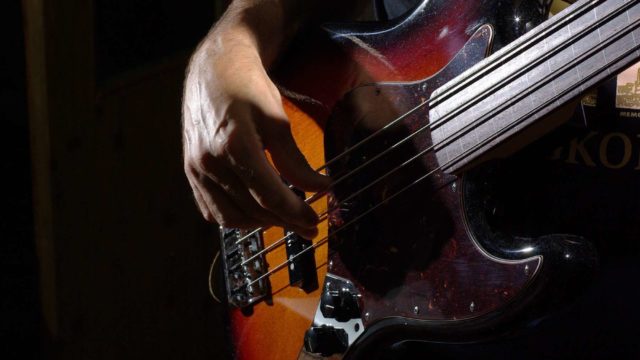
Orchestra Bass Guitarists are strong sight-readers who perform in many settings on board including Jazz, Top 40, Guest Entertainer & Musical Theater productions. Some ship positions also require bassists to cover Upright Bass. While sight-reading is essential, candidates must also have excellent feel, time, and the ability to play a variety of styles including Swing, Cha Cha, Rhumba, Tango & Funk.
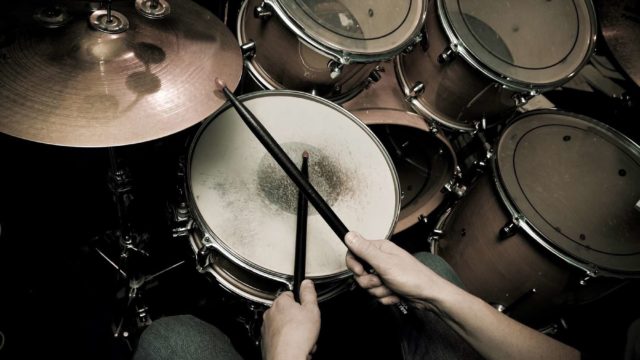
Orchestra Drummers are strong sight-readers who perform in many settings on board including Jazz, Top 40, Guest Entertainer & Musical Theater productions. While sight-reading is essential, candidates must also have excellent feel, time, and the ability to play a variety of styles including Swing, Mambo, Boss Nova, Rock & Funk.

Orchestra Guitarists are strong sight-readers who perform in many settings on board including Jazz, Top 40, Guest Entertainer & Musical Theater productions. Candidates must be comfortable reading notation and interpreting chords as well as soloing in Rock, Blues & Jazz formats.
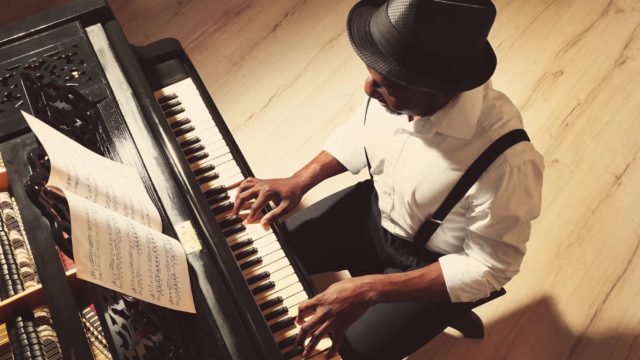
Orchestra Keys Players are strong sight-readers who perform in many settings on board including Jazz, Top 40, Guest Entertainer & Musical Theater productions. Candidates must be comfortable reading notation and interpreting chord charts as well as soloing in Rock, Blues & Jazz formats.

Orchestra Saxophonists are strong sight-readers who perform in many settings on board including Jazz, Top 40, Guest Entertainer & Musical Theater productions. Candidates should cover Alto Sax, Tenor Sax, Flute & Clarinet. While sight-reading is essential, Saxophonists should also have a strong improvisational soloing vocabulary.
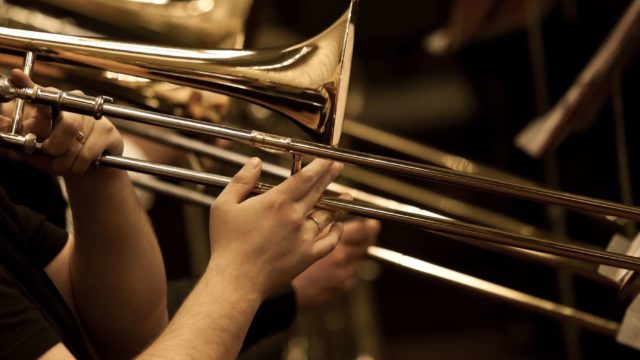
Orchestra Trombonists are strong sight-readers who perform in many settings on board including Jazz, Top 40, Guest Entertainer & Musical Theater productions. While sight-reading is essential, Trombonists should also have a mature tone and a good concept of phrasing, dynamics and vibrato.

Orchestra Trumpeters are strong sight-readers who perform in many settings on board including Jazz, Top 40, Guest Entertainer & Musical Theater productions. While sight-reading is essential, candidates should also have range with consistency and confidence.

Band Vocalists are versatile and engaging entertainers with the ability to work a crowd. Candidates should be able to cover a wide range of genres and styles with strong stage presence and impeccable pitch.
Solo Entertainers perform nightly, either in a dedicated room or a variety of venues on board. You should have a repertoire of at least 200 songs, covering genres from the 50’s to today. Successful soloists are engaging with themed or tribute sets.

Classical Guitar
Instrumental Guitarist who can play it all with a classy feel. Classical, latin, jazz, pop…ideal candidates have an expansive repertoire and the ability to play songs upon request. From Jobin to Santana, this cruise ship musician will have themed sets and the ability to take requests. Performances poolside, in the atrium for afternoon tea or in the martini lounge for pre-dinner cocktails, versatility and the ability to adapt are key.

Cocktail Piano
Aspiring Cocktail Pianists that want to become cruise ship musicians should have a large repertoire of songs ranging from Classical tunes to current Pop and Top 40 hits. Performance times and locations on board may include afternoon tea, early evening sail-away, or after dinner background music in a bar or cocktail lounge. The ability to sight read is benifical for special events such as weddings or anniversaries, as is the ability to add vocals, however, this is not required.

Solo Guitar/Vocals
John Mayer, Jason Mraz, James Taylor, Jimmy Buffett…these are just a few of the artists that a Solo Guitar/Vocalist should have in their song list for guest-requests and to create a fun and engaging atmosphere at their performances. This type of cruise ship musician can be found all around the ship in bars, lounges, poolside, on the back deck, or even performing in the theater or main atrium. Sing-a-long styles and guest requests make each performance unique, and an outgoing personality will help to ensure guests follow their favorite performer all cruise long. Looping pedals, harmonizers, and other pedal-effects are encouraged as they can add an additional dimension to performances, however, backing tracks, in general, are not preferred.

Solo Piano/Vocals
The personality to entertain a lounge and 88 keys to help them do it. Our Solo Piano Vocalists are some of the most engaging and entertaining cruise ship musicians in the world. Styles range from the 1950’s to current Pop hits and interactive performances include Theme Nights, Name-That-Tune, and Sing-a-Long favorites. Backing tracks should be avoided and the ability to field requests is required.
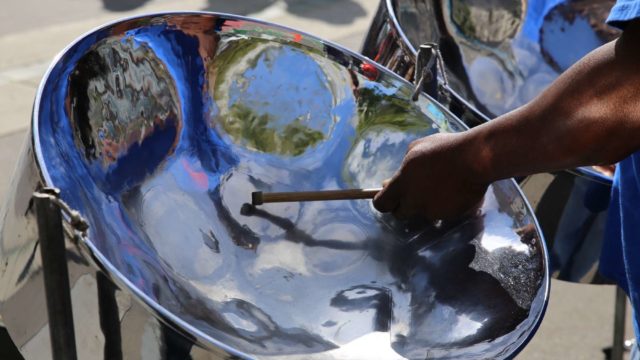
Solo Steel Pan
High-quality backing tracks and a talent for fun-in-the-sun Vocals & Steel Pan playing define the ideal candidate for the cruise ship musician position of Solo Steel Pan. Performing in several of the outdoor venues and moslty on Caribbean itineraries this entertainer should have a large variety of songs including Reggae, Pop, Oldies, Motown, and some dance and latin styles.
Ensembles/Bands perform nightly around the ship. Successful ensembles should have at least 200 songs, covering a variety of different genres (Motown, Jazz. Pop. Country, Caribbean). Your group should be engaging and should have themed or tribute sets prepared. These positions offer shared cabins, so bring musicians you want to live with!

Caribbean Ensemble
Including at least one vocalist, Caribbean Ensembles will be comprised of cruise ship musicians performing on the Steel Pan, as well a guitar, bass, keys, or drums. They should be versatile and comfortable performing poolside, at outdoor venues and bars, as well in lounges and cocktail areas. Guest requests will be common and the songs of Buffet, Marley, and Zac Brown will be the foundation of their repertoire.

Classical Ensemble
Classical Ensembles include Duos, Trios & Quartets performing in atriums, lounges and on the main stage. Ensembles must be well versed in Classical, Standards, Show Tunes & Contemporary styles as they set the scene for an elegant unforgettable guest experience.
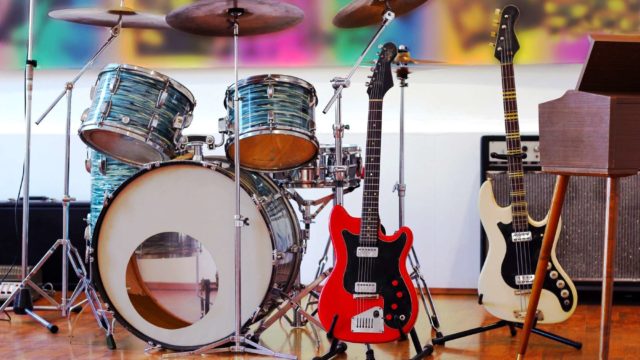
Dance Ensemble
Four cruise ship musicians that can perform everything from Miles Davis to Miley Cyrus. Dance Ensembles should have at least one vocalist and the ability of other members to cover lead or backing vocals is preferred. A lineup including Keys, Bass, Drums, and Guitar is optimal, however, there are opportunities for band with 3 of the 4, and a lead vocalist.

Two people, one big sound. Backing tracks, instruments, harmonies, and lead vocals all coming from two musicians on a cruise ship. Duos should have a song list of at least 250+ and be able to take requests and create an engaging atmosphere for every performance.

Jazz Ensemble
Real Books, Fake Books, and all of the Ballroom styles should be the wheelhouse for these Trios and Quartets. Keys, Bass, Drums, Guitar, and or Horn are the most common arrangement, and the bands should also be able to perform crossover styles of Pop, Top 40, Funk, and Blues.

Similar to a Wedding Band or Corporate Band on land, a Party Band consists of cruise ship musicians that can bring the party every night. Normally comprised of 4 or 5 members, these bands must have large song lists and it is preferred that multiple, if not all, of the members can add vocals. The most common arrangement is Keys, Bass, Drums, Guitar, and Lead Vocals. Theme Nights, Poolside Sets, and Dance Parties are where the guests fall in love the the Party Band and find themselves having the time of their lives.
Think you’ve got what it takes to be a cruise ship entertainer? Apply now
Luxury cruise lines are looking for musicians and bands right now! Several lines will only work with Landau Music: to get to them, go through us. Get paid to play while you see the world… For free!
Your web browser appears to currently have javascript disabled. This means that there are many elements of our website, such as the search system, that will not work as intended.
Please enable javascript and refresh this page. For instructions on how to do this, click here .
WANT A JOB ON A CRUISE ?
Bass player available, 30 years experience, elliot delamarche, guitarist for cruise showband.
Open for applications
Salary: £2040-2165
Male Rock Vocalist
Salary: 3.000 - 3500usd
Spring Cruise
Salary: Negotiable
MUSICIANS FOR CRUISES
- Help & Support
MEMBERS AREA
Musicians For Cruises has 157 listings , our latest listing is Guitarist For Cruise Showband (updated Tue 14 May 2024 ).
© 2019 - 2024 MusiciansForCruises.com trading as LastMinuteMusicians.com Ltd, Company #06544335 registered in England & Wales. By using this web site you agree to our use of cookies. Terms of Service | Privacy Policy | Made by 66websites.com

The Cruise Ship Musician’s Survival Guide Part 1
by Marisa Balistreri | Career , Band , Performing | 0 comments
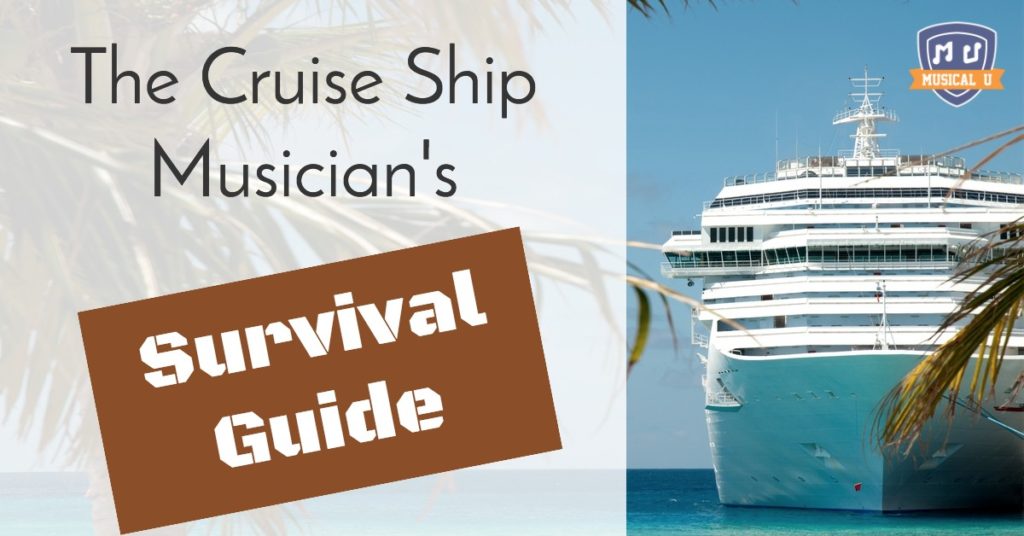
So. You want to work on a cruise ship. You’ve seen your musician friends working on ships post enviable pictures on Facebook and Instagram from exotic places all over the world—sunbathing in Barbados, walking the streets of Florence, snapping pictures of glaciers in Alaska—and oh! The crew parties! They seem to have it all, living the high life on the seven seas.
But are they really?
Now, before you say “Um yeah! Duh!” and rush off to sign your contract, let me ask you to consider the Pros and Cons of taking a job as a musician on a cruise ship:
- Pros: You get paid a lot of money to travel the world and play music with room and board included.
- Cons: You are stuck on a floating bubble with the same people for months on end.
Okay so you just skipped right over the “Cons” and decided to go. Fine, then! In the first of two blog posts on cruise ship work, I will tell you what basic ship life is like and give you some practical advice to prepare for it . In the second part I will talk about life on ships more in depth plus share some advice I wish I had been given before I signed my contract.
Disclaimer : I am speaking from my personal experience as a cast singer on the MS Maasdam (Holland America Line) for most of 2014. Things do vary from cruise to cruise, and company to company.

Before You Go
Here are some things to prepare for:
- You must be in good physical shape , so you will have a mandatory physical exam before you board—including drug testing. There is a very strict no drug policy on ships. Make sure you clear all prescriptions with the ship’s doctor. We were given some vaccines and flu shots on board.
- Make sure you have any passport, visas, and papers in order.
- Have a credit or debit card for port . Your cash transactions will mostly be on the ship.
- Know the cash withdrawal rules and crew office hours ahead of time so you don’t find yourself without cash those first few days!
- Don’t overpack. Your cabin will be very small. You will be hauling your stuff on and off the ship yourself. I invested in collapsable duffle bags.

Ship life is as great as you think it is in many ways, but there are rules. Let’s go over some of the things that will be expected of you on board.
I once said that working on a ship is a little bit like working on a gorgeous floating prison. No, of course, it’s not exactly a prison, but you are not free . You can’t come and go as you please. You will have ship duties that keep you living under strict rules. You must dress and behave a certain way—even in crew areas. (No flip-flops!) There are reasons to be granted ship leave, but those reasons are not always paid.
Oh and by the way, you can forget keeping track of the day of the week —or even the month or season for that matter. There are only sea days and port days from now on.
A Day in the Life of a Musician
Ship musicians can expect to be busy . Most ships have music positions scattered around the ship—piano bar, classical ensembles, solo guitar, jazz trio and other small groups. The piano bar entertainer can expect to have very few nights off to rest the voice . The small music ensembles will generally play several sets a night.
Cast members can sometimes expect to be bored . Shows are not repeated, so if you have a long cruise, such as a forty-two-day cruise to Brazil with seven shows (you do the math), bring plenty of books and movies on board with you. Again, this all varies from ship to ship.
The busiest position is the party band. They play in the afternoons for arriving passengers, two stage shows in the evening and then dance music in the lounges at night. There will be afternoon rehearsals with guest artists and regular soundcheck rehearsals with the cast.
You will have very little time to prepare with guest artists, who bring their own charts and tracks. For this reason, ship musicians are expected to be excellent sight-readers, and if you apply for a job, you will have to pass a sight reading test.
Safety Duties
It’s a ship and every crew member—and that means you—is expected to contribute to the safety of it.
On the Maasdam, as entertainment staff, we were also “traffic directors”. That meant that we were responsible for mustering passengers to their lifeboats in an emergency. (It also meant that we would be the last people off the ship but oh, well.) All crew members must attend safety meetings, regular boat drills, and the occasional Coast Guard inspection.
Also, all crew members must participate in “In Port Manning” (IPM) rotation—that is, on port days, a certain number of crew members must stay on the ship for safety reasons. Look at it this way—it’s a great opportunity to work on your IPT (“ In Port Tanning ”)
Sometimes if you’re really nice, you can get one of your colleagues to swap with you.

Stay Healthy
Ships take health very, very seriously. You can be fired for not reporting a gastrointestinal (GI) infection. If you do become ill, both you and your roommate will be quarantined. Believe me, you do not want to know what a “code red” (GI outbreak) cruise is like. The ship really does become a prison for everyone. Wash your hands, wash your hands, wash your hands!
Mercifully I was never all that seasick, but it happens. The boat rocks. A lot. Sometimes it was a little bit like performing on the A Train with three inch heels with nothing to hold onto . It took me three weeks to get my “sea legs”. Are you are prone to seasickness? Be sure to get medication for that before you board.
Know Your Place
There is a ship hierarchy. As a musician you end up somewhere in “the middle”. Expect to be treated well and have a lot of privileges that many crew members do not have like eating in the restaurants, using the pool and passenger gym, and discounted spa rates. Appreciate them because there are hundreds of people working on board who work twice as many hours as you for less than half your pay who don’t have your privileges . And they always work with a smile. Be kind to your cabin steward. Tip them well.
What Party?
And what about that endless party? If you’re wobbling up the gangway after an afternoon in Aruba, you may be stopped and randomly tested. And fired. It happens. Expect random searches of your cabin. Are you out after curfew? You will get written up by security. If you get written up too many times, you will also be fired.
That said, there is always a wonderful comradery every night at the crew bar after work and shows have wrapped up . This is the time to let loose, have a few drinks, have fun with your new friends and play some darts. After we were done working we would very often go around the ship and listen to the other music groups on the ship play, and sometimes sit in with them. Also, there are often crew parties scheduled. These can be a bit a bit out of hand but will definitely create some lasting memories!
Speaking of parties…
Now that we’ve gone over the basic rules and structure of ship life, be ready to take notes! There are some aspects of cruise ship life that I learned about the hard way. In the next part of the Cruise Musician’s Survival Guide, I’ll go over the things I wish someone had told be before I boarded ship.
Submit a Comment Cancel reply
Your email address will not be published. Required fields are marked *
Save my name, email, and website in this browser for the next time I comment.

Listen/Watch The Podcast:

- The Circle of Fifths
- Interval Ear Training
- The Dorian Mode
- The Pentatonic Scale
- What is Kodály?
- How to Sing in Tune
- Four Chord Songs
- Syncopation
- Tune a Guitar By Ear
- Chord Progressions
- Common Chord Progressions
- Minor Chord Progressions
- Blues Music
- Time Signatures
- Polyrhythms
- Playing By Ear
- Progressions
- Perfect Pitch
- Active Listening
- Song Writing
Download free ear training apps to help you improve your ear for music:

Musical U » Career » The Cruise Ship Musician’s Survival Guide Part 1
Skip to Content
- Eastern US Music Schools
- Central US Music Schools
- Western US Music Schools
- International Music Schools
- Arts High Schools
- Summer Music Programs
- Scholarships
- Read Articles
- Testimonials
- Music Major Blog
Playing Music on Cruise Ships: Know Before You Go
Thinking about playing music on cruise ships? Our first article on this topic, Performing Music on a Cruise Ship: Is This Your Dream? , prompted many additional questions. We decided to ask for advice from drummer Cameron Hicks, who’s currently playing music on cruise ships across the world. He shares great insights and suggestions gleaned from experience.
by Cameron Hicks
1. How musically proficient do musicians on cruise ships need to be?
Orchestra musicians should should be able to proficiently sight read, play with a click, easily handle tempo changes, play several styles (including styles common for production shows, big band, jazz, etc.), and proficiently speak English (may sound weird or biased but is very important).
Lounge musicians should have a large repertoire of recognizable and appropriate music. Each lounge act is its own entity. And cruise lines have pretty specific ideas as to what they’re looking for. For example, they may want a solo guitarist to play guitar and sing, or a jazz quartet that includes a singer (which is almost always the case). That said, I would never tell a band not to send in for a job. You just might be what they want!
2. What have you found to be the best way to go about finding a job performing on a cruise ship?
The easiest way I found is to go through an agency. They generally work with several cruise lines and have quickly found me work.
3. Who is your main contact once you get the job offer? And who is your main “go to” person once you’re on board?
I stay in constant contact with my agent. Agents will let you know about flight details and other important things you need to know.
Once on board the ship, my direct manager is the Bandmaster who is in charge of all the musicians on the ship. This is typically a musician in the orchestra who creates the daily schedule for all the ship’s musicians. The cruise director is in charge of the entire entertainment department.
4. What’s a typical day like on board the ship?
As an orchestra musician, I generally have a rehearsal and/or tech run sometime during the day. The time varies depending on when the performance theater is available. These are either for a production show with the cast or with a guest entertainer. Generally you won’t see the music before this rehearsal.
On days when the orchestra isn’t needed in the theater, we usually play one to four lounge sets – either big band or jazz.
5. In addition to playing music, what are you required to do?
There is one mandatory emergency drill with passengers on each cruise. Crew members are given duties to perform during this drill. This can include crowd management, life jacket demonstration, announcements, etc. There are also emergency drills required of just the crew.
6. Where do you store your instrument? Do you have access to it when you’re not performing?
If you’ve brought your own instrument, you are responsible for it. I’ve seen some ships with safe places to store instruments backstage, but this is not the norm. Musicians generally have to store their personal equipment in their cabins, which are small!
If you have your own instrument you always have access to it. Most musicians are also able to find a place to practice (harder for drummers due to the noise factor).
7. What can you do to make the most out of each cruise?
It’s a good idea to create a list of two or three (realistic) goals and schedule your personal time around them. I’ve heard people who want to save money, practice, see as many new places as possible, make new friends from as many countries as possible, etc. Several of these are possible but having too many goals can be a problem.
8. What essentials will cruise musicians need to bring with them and keep handy?
- Valid passport (not expiring just before, during, or right after the cruise)
- Valid ID (in addition to the passport)
- Medical exam – each cruise line has a medical exam you must pass to be allowed on board. If you forget the paperwork you will not be allowed on.
- Your instrument (check with your agent to see what’s necessary)
- Headphones and 1/8″ to 1/4″ adaptor for click track
- Visas – your agent will probably help you with this, but do some research about the countries you’ll be visiting regarding visas. It’s possible you’ll need one or two to get off the ship in certain ports (even if you’re an American citizen).
- And don’t forget to tell your bank/credit card companies where you’re going! Otherwise, it’s likely your card will be frozen after the first few purchases and you will probably not have cell service to fix the problem.
9. What’s the best way for a musician to pack for a cruise gig?
Don’t bring too much stuff!
I mention this for two reasons. First, there is very limited space in your cabin and you will most likely be sharing it with another person. Second, you will be traveling alone and likely end up in a foreign country pushing your way through an unfamiliar airport trying to figure out how to get to your hotel. You will also be carrying your luggage through small hallways on the ship when you get there. Make sure you can carry all of your luggage by yourself!
Even though you may be away from home for six months at a stretch, don’t worry –– there are laundry and dry cleaning services on the ship.
For more information on packing see How I packed for a two-month Alaska cruise .
10. Which instruments will the ship have on board? And how’s the quality?
The only instruments I’ve ever seen provided are drumsets with hardware (no cymbals), pianos, and keyboards. The quality is decent. If these need repairs or parts, you can talk to the Bandmaster to see how the problem can be fixed.
11. What’s the average age range for cruise ship musicians?
The majority of musicians I’ve met have been in their 20’s or 30’s, but there’s always a range of ages.
12. What kind of non-compete policies have you had to work with?
The only non-compete I’ve seen is with my agency.
13. What if you were to get sick on board the ship? What do you do about health care and health insurance?
There is a medical center on board for dealing with any illnesses that may arise. Check with your cruise line to see how you’ll be covered. Also check with your own health insurance plan. It’s a good idea to have health insurance that will cover you beyond whatever the ship offers.
14. Any final words of wisdom?
Take a camera and have fun!
Cameron Hicks received his BFA in Jazz Studies from California Institute of the Arts (CalArts) in 2012. He is a drummer and composer who performs, tours, and teaches professionally.
Will June 26, 2020 at 12:45 am
What type of agency is he talking about?
MajoringInMusic June 26, 2020 at 2:46 pm
There are entertainment agencies that specialize in helping cruise ship musicians and other entertainers find work. With the changes in the cruising industry brought on by the pandemic, it’s hard to know how this will be handled in the near future, although some of these agencies say they’re still reviewing applications and preparing to hire performers as soon they can. You can learn more by checking the websites of cruise lines directly since some have their own in-house entertainment directors; also try googling “cruise ship entertainment agencies.”
Gary November 12, 2016 at 11:10 am
Outstanding advice. Cameron has succinctly covered all of the must-know facts about working as a cruise ship musician. I would add to try and get in touch with the bandmaster/musical director (MD) prior to departing. That way you can find out about ship-specific things (do you need suits, tuxedo, all black, regs on open-toed shoes for women etc.) You can also find out if any performance prep resources are available like digital copies of production show music or recorded track stored in a drop box account. Emailing the ship’s MD ahead of time may also help you make better packing decisions. – G. Beamon, Lead Trumpet, Royal Caribbean Cruise Line
MajoringInMusic November 16, 2016 at 7:49 pm
Thank you for the great suggestions!

Leave a Reply Cancel reply
Your email address will not be published. Required fields are marked *
Join our mailing list
- Explore Schools
- Discover Music Careers
- Find a Summer Program
- Request Consultation
- All Articles
Privacy Overview
Find your school.
Explore schools and request information on their individual pages, OR... use this form to select multiple schools you want to learn more about. (* indicates required field.)
- Name * First Name* Last Name*
- Email Address *
- City and State
- Current School
- Current Grade Level
- Area of Musical Interest
- My primary instrument
- Secondary instrument
- I particularly would like to know more about the following:
- Select Schools (scroll to select multiple schools) Go first to the music school pages, then come back here to only select schools you have researched as fitting your criteria. Arizona State University School of Music Bard College Conservatory of Music Berklee College of Music Blair School of Music at Vanderbilt University Boston Conservatory at Berklee Boston University School of Music Butler University School of Music Case Western Reserve University CalArts Herb Alpert School of Music Carnegie Mellon University School of Music Chicago College of Performing Arts at Roosevelt University Coastal Carolina University Colorado State University Department of Music, Theatre and Dance Concordia University Irvine DePaul University School of Music Duquesne University Mary Pappert School of Music East Carolina University School of Music The Eastman School of Music of the University of Rochester Elon University Florida State University College of Music Gettysburg College Sunderman Conservatory of Music The Hartt School Idyllwild Arts Academy Indiana University Jacobs School of Music Interlochen Center for the Arts Ithaca College School of Music Kutztown University Lawrence University Conservatory of Music Leeds Conservatoire (UK) Liverpool Institute for Performing Arts (LIPA) Los Angeles College of Music (LACM) Loyola Marymount University Dept. of Music Manhattan School of Music Mannes School of Music McGill University Schulich School of Music Metropolitan State University of Denver Northeastern University Department of Music Northwestern University Bienen School of Music Oberlin Conservatory of Music Occidental College Dept. of Music Peabody Conservatory Penn State School of Music San Francisco Conservatory of Music School of Jazz at the New School SMU Meadows School of the Arts Susquehanna University Temple University Boyer College of Music & Dance The Conducting Institute Tiffin University University of Cincinnati College-Conservatory of Music (CCM) University of Colorado Boulder College of Music University of Colorado Denver Music & Entertainment Industry Studies University of Denver Lamont School of Music University of Memphis Rudi E. Scheidt School of Music University of Michigan School of Music, Theatre & Dance University of North Carolina School of the Arts University of South Carolina School of Music University of the Arts University of Toronto Faculty of Music USC Thornton School of Music Valparaiso University VanderCook College of Music Walnut Hill School for the Arts Wayne State University West Chester University Wells School of Music Wheaton College Conservatory of Music
- Email This field is for validation purposes and should be left unchanged.
- US & Canada: 1 888 477-6744
- International: 1 514 485-8823
Join our Newsletter
Welcome to Proship Entertainment
Register with Proship today and let one of our staff find you a great performance opportunity.
About Proship
We began sourcing musicians for the cruise ship industry in 1987. Since then we have booked over 20,000 contracts for entertainers all around the world. Cruise lines, hotels, casinos and other entertainment venues seek us out because they know that our connections and ability to match opportunities with performers are second to none.
WHY PROSHIP?
You've worked hard to learn and develop your skills as a performer. With Proship you have an entire staff of experienced performers who want to help you make the most of your talent. We appreciate your abilities and ambitions, and are dedicated to finding you an opportunity to earn good money performing in world-class international venues.
Get the right job for you
Proship is on your team, working with you side by side to find you the best possible performance opening. We provide you the support you need to get the gig and make the most of the experience. Work opportunities are only as good as the people behind the scenes making it happen for you. The majority of our staff are career entertainers who understand your needs and concerns and will help you find the opportunity that will best compliment your talent.
Travel the world
Need a change of scenery? Imagine yourself working in those amazing places around the globe that you’ve always dreamed of. The people we place get the opportunity to work everywhere on earth, from the sun-drenched beaches of the Caribbean to the ice carved fjords of Alaska, via the historical capitals of Europe or the mysteriously exotic ports of Asia. Your experience with us will enrich your life.
Get paid well to do what you love
Proship entertainers make top dollar. Our clients hire us to find the best performers there are, so they expect to pay more. When our clients competitively compensate the entertainers, we get higher quality people willing to take the gigs, and in the end, we deliver better entertainment. It’s a win-win-win scenario. Room, board and transportation are usually provided by your employer, so you can save most of what you make.
Don't pay commission fees
Proship gets paid for our services directly by our clients, the corporations, cruise lines, hotels, resorts, casinos and other entertainment venues. Unlike some agents, we do not take commission fees, audition fees, or registration fees from the performers we hire.
Support for you
Proship is your support partner throughout the entire employment process. We audition and evaluate each performer we find to ensure you perform with other qualified individuals. We seek employers that offer outstanding opportunities and negotiate work conditions that make a difference to you. Once hired, our contracting department will support you through the entire logistics process assisting you with physical examinations, visas, rush passports, background checks and contracts. You will also have access to a live 24/7 emergency travel support line from anywhere in the world.
Opportunities
There are countless opportunities for skilled musicians to work all over the globe! Whether you work solo or as a group, whether you are a sight-reading musician for the pit orchestra, a member of a contemporary band for a dance club, a string ensemble for a lobby, a solo instrumentalist for the main stage, the hotel, resort, casino and cruise ship industries are interested in your talents.
Showband Musicians
Solo musicians, guest entertainers, disk jockeys, technicians.
The showband musician or orchestra musician is a member of the show orchestra performing and supporting all main stage performances. If you play piano, bass, drums, guitar, trumpet, sax, or trombone and can sight-read and improvise we have opportunities for you.
You play with a versatile musical group that is ready to travel? If your duo, trio, or quartet covers lounge, contemporary, top-40, classical, Broadway, jazz or Latin repertoire, Proship has opportunities for you.
You can create an ambiance and entertain audiences on your own as a harpist, a guitar intermissionist, an accordionist or a cocktail pianist? You can rock the house as a piano bar entertainer, or a one man band with a massive sing-along repertoire? You are a world-class virtuoso instrumentalist with your own show leading to a standing ovation? Proship has opportunities for you.
They say you have the voice of an angel. Now it’s time to showcase it to the world! If you are a lounge singer, a vocal virtuoso mastering many languages, a rock and roll singer, a stage cabaret performer with your own feature show, or a classically trained show diva, Proship has opportunities for you.
Dancers usually perform as part of a full cast of singers and dancers on stages in hotels, casinos, cruise ships, clubs and theatres all over the world. You are trained in ballet, jazz or tap? You have acrobatic or circus specialities? You can carry a song? Proship is pleased to bring a world of performance opportunities to professional dancers.
Whether you are an acrobat, a stand-up comedian, mime, contortionist, aerialist, magician, puppeteer or juggler, there is always a need for original, savvy entertainment. Typically, your number can comprise of a solo, duo, trio or quartet. Does your number lead to a standing ovation? Proship has opportunities for you.
Are you a seasoned Disk Jockey versatile and competent with a wide array of demographics? Are you well experienced in a club, a discotheque or a wedding environment? Can you work the microphone, entertain the crowd and get the room moving to your beat? Does your knowledge of popular music encompass all eras from the 1920’s to today? Proship has opportunities for you.
Technicians bring to life the stage and everyone on it! They are the essential building blocks of entertainment and the need for top qualified technicians is ever increasing. Are you an audio-visual wiz? Are you a professional sound technician? Are you well versed with the art of lighting? Are you an experienced stage manager? Are you a specialist of human rigging? Are you ready for travel and excitement? Proship has opportunities for you.
Our Clients

- Volume 24 (2023)
- Sounding Board
- Volume 22/1 (2020)
- Volume 21 (2017)
- Volume 20 (2015)
- Volume 19 (2014)
- Volume 18 (2013)
- Volume 17 (2012)
- Volume 16 (2011)
- Volume 15 (2010)
- Volume 14 (2009)
- Volume 13 (2008)
- Volume 12 (2006)
- Volume 23/1
- Volume 10 (2001/2002)
- Volume 09 (1999)
- Volume 08 (1997)
- Volume 07 (1995)
- Volume 06 (1991)
- Volume 05 (1987)
- Volume 04 (1987)
- Volume 03 (1986)
- Volume 02 (1985)
- Volume 01 (1984)
Corporately Imposed Music Cultures: An Ethnography of Cruise Ship Showbands
Introduction .
One night in the middle of a cruise, amidst the lights, noise, and scantily-clad dancers of an evening production show, the showband pianist quietly slipped off the bandstand and moved to the wings. There was nothing unusual about this; it happened every time the production show was performed. On cue with the singer, he moved to the middle of the stage where a convincing mock-up of a grand piano was spotlighted. He sat down and pretended to move his fingers over the keys, miming to a recording while the singer writhed atop the constructed piano. Finishing, the pianist returned to the bandstand and continued with the show. After the curtain dropped, he put his charts back, made his way to the crew bar for a few drinks, and put the mimicry from his mind. The next day, in the breakfast buffet line, an older passenger stopped him, saying how much she loved jazz and had particularly enjoyed his solo in the show last night. The pianist, not wishing to shatter her illusions, simply thanked her, and moved on to his scrambled eggs and grapefruit juice.
The guest’s misinterpretation of the veracity of the performance is understandable, as the cruise ship entertainment product relies on fabrications of culture (Wilkinson 1999). Aboard a cruise ship, one is accosted by fabricated jazz clubs (Cashman 2013a), surf (FlowRiders), rock-climbing cliffs (Kwortnik 2008), representations of cultural performances (Cashman and Hayward 2013), and gardens (this last aboard some of the Royal Caribbean ships). Cruise ships are “polyvalent leisure environments” and “money traps” (Chardon 1992), and the very essence of post-tourism.
The creation of new and fabricated touristic products is not, of course, limited to cruise tourism, nor to post-tourism. The demands of twenty-first-century tourism include the pre-packaging and commodification of cultural representations. Tourists who particularly seek out cultural experience are referred to as “cultural tourists,” a term used by Erik Cohen (1979) to navigate the counterpoint between Daniel Boorstin’s view of tourists as dupes (1961) and Dean MacCannell’s view of them as seeking (but not necessarily finding) authentic culture (1976). However, the constructions of culture they do find may overemphasize “pastness, exhibition, difference, and where possible indigeneity” (Kirshenblatt-Gimblett 1995:370). The processes of postmodern tourism—also referred to as “post-tourism”—are similar though the intent is markedly different. Post-tourism creates value by the construction of fabricated and hyperreal culture (Kirshenblatt-Gimblett 1995:396; Eco 1986). Controlled and closed sign-systems invite guests to engage playfully as in a game, an idea core to the concept of post-tourism as originally expounded by Maxine Feifer (1985). Thus, both cultural tourists and post-tourists engage with a cultural construction; however, cultural tourists encounter representations that profess authenticity, while post-tourists (including cruise tourists) engage playfully with an overt fabrication that is not designed to be “real.”
Cruise ships are examples of post-tourism, because value is contained within these constructed sign-systems (Berger 2011; 2004). The constructed onboard culture (especially the music culture), presented as an alternative to the perceived authenticity of cultural tourism, is implemented by the corporate decision of the shipping line. Cruise tourists engage with this constructed culture, aware that the music culture offered by cruise ships is neither maritime nor local, but is a diversion that permits engagement at a superficial and uncritical level. Indeed, the cruise ship goes so far as to actively reject the very physical and cultural environments in which it finds itself (Cashman 2013b) rather than interacting with the oceanic environment in the manner of an aquapelago (Hayward 2012). Rather than comprising an engagement with a visited society, cruise tourism comprises “a social and cultural practice, that . . . reflects and embodies the values and norms shared by the members of a particular group or society” (Vogel and Oschmann 2013:5). A cruise ship is a container for a temporary society formed of two codependent groups, the guests (“tourists”) and the crew (“locals”). Guests are literally and figuratively encapsulated within the cruise experience for an extended period, obliged to interact with a fabricated, ambiguously “western” culture provided by the cruise line and by the crew (acting under management instructions).
The consideration of authenticity has been a more-or-less constant debate in tourism studies for the past fifty years. For Boorstin (1961) and MacCannell (1976), authenticity was something that existed behind the tourist facade and was impossible to present to tourists. For Ning Wang, authenticity was an existential concept, incapable of being constructed (1999). More recently, for Britta Tinn Knudsen and Anne Marit Waade, authenticity is something negotiated between tourist and local (2010). Cruise tourism, however, is a post-tourism product (Berger 2004, 2011; Nilsson 2007; Vogel and Oschmann 2013; Weaver 2005), and as such, the quest for authenticity is not a significant factor in the construction of cruise ship culture.
Such fabricated cultural representation is, of course, common within tourism. Hotels from New York to New Delhi co-opt signs of western culture within their hotels and tourism environments, creating such a homogenous western experience that the superficial touches of local culture stand out (Culler 1981). Postmodern and hyperreal tourist destinations including cruise ships, theme parks such as Disneyland (Carson 2004, Pachter 2009), and themed cities such as Las Vegas (Loi and Kim 2009, Loi and Pearce 2008, Wood 2005), construct and represent cultures with which tourists interact. At most of these venues, guests escape to their own lives and cultures at the end of the day.
This article discusses the construction and presentation of the fabricated music culture of cruise ships. It is an unusual ethnography in that the culture under discussion is not the result of humans living together, but one constructed by corporate decree. The “local residents” of the cruise ship (i.e. the crew) do not inhabit the cruise ship by birth, but for reasons of economic necessity, adventure seeking, or interest in becoming tourists themselves. I focus my attention in this article on the ship’s showband. This ensemble is core to the cruise experience. While other ensembles perform in their particular cruise venues, the showband performs in various locations around the cruise ship. Moreover, the showband typically accompanies the main evening show that frames and focuses the cruise ship entertainment product.
This research is the result of an extended period of participation/observation as the author undertook employment on several cruise ships. Following this, surveys and formal interviews were conducted with cruise ship musicians, other onboard employees, and shoreside personnel; which created a mixed-method approach to data collection and analysis. As the focus of the research is on the corporate cruise ship culture, interviews were not undertaken with guests, who form a temporary addition to the cruise ship.
Cruise Ship Music Culture
Cruise ships are now so large that they can be described as “shipscapes” (Kwortnik 2008), as “mobile tourist enclaves” (Weaver 2005), and as mobile geographies unto themselves (Cashman 2013a). The RMS Titanic (1912) that displaced 46,328GRT, was the largest ship in the world at the time. 1 By contrast, the latest Oasis-class mega-cruisers operated by Royal Caribbean International displace 225,282GRT. They utilize solar power, contain sixteen passenger decks, and are constructed as “neighborhoods” with living parks, theatre districts, and dining areas. There are now nine ships over 140,000GRT, all built within the last decade; nine more will be delivered over the next four years. Such large constructed geographies create and define an area within which humans can live, creating temporary cultures which last the length of the cruise, which can be as short as three days or as long as four months.
These mobile geographies have also been referred to as “cocoons,” as they protect guests from the realities of the environments through which they pass (Huang and Hsu 2009; Mastin 2010; Papathanassis and Beckmann 2011; Vogel and Oschmann 2004). For example, ships limit interaction with the natural aquatic environment, while fabricating and mediating guests’ interactions with water (Cashman 2013b). Instead of interacting directly with the aquatic environment, guests are accosted onboard by enormous waterslides, fabricated surfing experiences on Royal Caribbean’s FlowRiders, and water features in atriums. Many companies also lease islands from Caribbean nations, altering the physical environment to match popular representations of island paradises. Disney, for example, unhappy that the original state of its island (which it renamed Castaway Cay) did not match the popular perception of a Caribbean paradise, dredged sand from the middle of the bay, cleaned it, ground it up finely, and deposited it on the beaches (Wood 2000:362).
In the same way, the culture of cruise ships is constructed to keep the tourists (“faux-voyageurs” in the words of Jean-Didier Urbain [1986:295] and John Frow [1990:127]), from interacting with the local cultures through which they travel. In fact, potential interaction with local culture, Robert E. Wood notes, is often disturbing to and unwanted by cruise ship guests (2000:360). Contact with local culture is mediated through “shore excursions” to locally-themed tourist attractions within and around the port area (Jaakson 2004), or through the provision of onboard “local shows,” choreo-musical presentations of local culture (Cashman 2011). 2
Cruise ships delineate western culture by a series of semioses that are purposefully implemented and offered to guests. The external and internal design of the ship is opulent and deemed aesthetically beautiful by western standards. Western linguistic and textual signs are imposed by the use of English in public areas of the ship. 3 Musically and choreographically, western culture is presented by the performance of western music, often popular western music, to guests. In some cases, representations of other cultures are incorporated into this culture as signifiers for “exoticism,” for example, by the use of a resident Caribbean or Latin band, or of the “local” shows. However, overwhelmingly, the majority of cultural representation is of western culture.
In the constructed and mobile geography of the cruise ship, the “local” residents are the crew. However, these “local” residents are from many different ethnic groups. Gibson notes that in some cases a single crew may comprise more than fifty nationalities (2008:45-50). Typically a single crewmember will undertake a contract that may last a few months or more than a year. The crew thus comprises, in a very real sense, a floating population of individuals coming and going from the ship, living in extremely close proximity to each other and speaking a variety of languages. This comprises an unusual culture in many ways; significantly, it is a culture created by corporate decree.
The Music Culture of Cruise Ship Showbands
There are several types of musicians onboard cruise ships. There are ensembles of collectively-contracted musicians who perform a popular representation of a particular genre (e.g., jazz, classical, or rock) in a themed venue. Soloists operate in a similar fashion, but are individually contracted and perform on their own. Guest entertainers perform the evening cabaret show and can be musical (singers or instrumentalists) or non-musical (usually comedians, jugglers, or ventriloquists). Production singers and dancers comprise the onboard “cast” and perform in the themed production shows. The focus of this study is on the fifth category, the showband, also known as the ship’s orchestra. It is the showband’s musical responsibility to accompany the evening guest entertainer or production show and to perform in various locations around the ship as needed.
While a version of the showband exists on every large cruise ship, they vary in size and lineup. Most often, the showband consists of between five and nine performers and is of two kinds: the “traditional” showband is a cut-down swing band with a horn section (often consisting of trumpet, one or two saxophones, and trombone) and a rhythm section (usually piano, bass, drums, and guitar). This instrumental lineup permits the group to perform jazz standards well, but some instruments become superfluous in the performance of rock. The “modern” showband, which is used on some Carnival Cruise Lines vessels and on the Holland-America Line, is an adapted version of the band on the American television program Saturday Night Live . It is comprised of a single saxophone and rhythm section (in Holland America’s case, augmented by a second keyboard) and is able to perform rock more easily than swing.
Musical ensembles akin to the showband have existed on passenger shipping since the 1880s (Cashman 2014). The showband is descended from the bands of earlier passenger shipping, such as the famous Titanic musicians. The first ensembles were brass bands on the German Norddeutcher Line, which performed arranged parlour music, light classical music, and German melodies. From the early 1900s, string players appeared on Cunard and White Star, but the emphasis would remain on performing classical music for first-class passengers until the 1920s and 1930s. From this time, dance bands began to appear on passenger ships and would remain until the dawn of modern cruising in the 1960s and the establishment of the showband proper. While the focus of the job has changed from this early time, the fundamental requirements have not.
Participants
Showband musicians, through their ethnicity, education, and backgrounds, say much about the focus of the constructed culture of the cruise ship. These musicians are obliged to be well-trained in western popular music, particularly in jazz and rock. They ideally must be both strong improvisers and strong readers, as the showband may be called upon to perform a variety of genres including light classical music, rock, jazz, and ballroom dance music.
In the welcome aboard show held on the first night of a cruise, a standard line used by many cruise directors makes reference to how well the many nationalities aboard the ship get along. The ship, they say, is a veritable “mini-United Nations,” and “the real U.N. could learn a thing or two from us.” The reality is quite different, with a near-caste system of officers at the top, staff in the middle, and crew at the bottom. Crew from certain countries (particularly Indonesia and the Philippines) are paid less for doing the same job as their counterparts from other countries (Wood 2000:353-358). Musicians, considered to be staff, are in the middle of this hierarchy.
Showband musicians tend to be young, though older musicians also exist. While 30% of the musicians sampled were under the age of thirty, none were under twenty-five. By contrast, 25% were over forty-five, and 7% were over sixty. Showband musicians are far more likely to be male (83%) than female (17%). They may be of a variety of nationalities, but are traditionally from western countries, such as the United States, Canada, UK, and Australia. In fact, showband musicians are more likely to be from western countries than almost any other group of shipboard employees. In recent years, however, there has been an attempt to employ showband musicians from Southeast Asia (especially the Philippines) and Eastern Europe. However, informants report that, from a musical point of view, this has been generally unsuccessful because of the perceived lack of reading ability among Filipino musicians (though they are considered excellent improvisers) and of improvisational ability among Eastern Europeans (though they are considered excellent readers). However, as the salary of musicians from these countries is lower, it has been successful from the financial point of view of the cruise lines. Cruise ship musicians are also highly educated, with 77% of surveyed musicians holding a tertiary qualification, compared to 27% of U.S. citizens (U.S. Census Bureau 2009) and 24% of Australian (Australian Bureau of Statistics 2007). Showband musicians are typically contracted for around four months, though shorter and longer contracts exist. They sign onto ship’s articles, meaning that they are governed by the laws of the country of the Flag of Convenience (a process by which a ship is flagged in a country apart from that where the shipping line headquarters is located) and are subject to the discipline of the captain.
The social structure of showband musicians’ music culture is controlled and defined by two aspects: musical ability and social skills. Of the two, musical ability is of vastly greater consequence. Cruise ship musicians, like many performing musicians, are harsh judges of talent and impatient with sloppiness, requiring of others the same standards that they demand of themselves. Showband musician Brett Caine gave the following advice to a hypothetical guest entertainer:
Hey, here’s an idea. . . . Take some vocal lessons, learn to play your instrument, study the best comedians and learn from them before you bring your crap-ass little dog and pony show out here to my ship where you’ve spent more money on your freaking wig and make-up than you have on your charts! This ain’t supposed to be amateur hour, and you’re wasting my time making you look better than you really are! (Interview, 2011) 4
While social skills are of secondary importance, they also form a part of the social structure. The highest rung of showband culture is the “great musician, great guy,” who enjoys strong support from all players. Lower quality musicians are pegged lower on the structure of shipboard society, even if they are personable. The lowest rung of the social ladder is reserved for those of low social and playing skill.
While musicians generally feel positive about the cruise experience, the continued commodification of their art coupled with the repetitive nature of the music they create can cause long serving cruise ship musicians to become “dark.” “Darkness” is an industry term for feelings of general negativity, helplessness in the face of perceived harassment by management, and depression. It is manifested in a darkly humourous and aggressive manner among musicians between themselves. Musicians wear their “darkness” as a badge of pride. It signifies that a musician has been on cruise ships long enough to become dark and is unafraid of consequent harassment by the official shipboard hierarchy. This attitude can encourage other musicians to also develop negative attitudes towards their employment. Showband musician Thomas Mason describes the phenomenon of “darkness” as the result of disappointment in musicians’ employment:
Too many of us believe in some mythical, perfect gig out there that simply doesn’t exist, and consequently we get dark about whatever job we’re currently on. Normally we’d walk away from the gig at the end of the night, get up the next morning, and go on to the next thing; but on the ship you do it day after day after day. There is no home to go to; you live there. You constantly put up with the petty rules and regulations of a wannabe navy that has little (other than the corporate office) to keep it in check. It’s a dictatorship, and what the officers say goes. Combine that with the sheer boredom and monotony that occurs when you don’t go out of your way to mix it up, and things get dark fast. (Interview, 2011)
Cruise ship crew, including musicians, have a tendency towards substance abuse, a position tacitly (and sometimes actively) encouraged by cruise ship management. 5 In the documentary, Ships , a cruise ship officer says,
[When you arrive onboard] you have two options: either you have fun, or you don’t have fun. Go for the first option. Have fun! Enjoy what you do! Be proud of your job. At the end of the day, hang out with your friends. Have fun! Drink! If you don’t want to drink, don’t drink. But if you want to drink, drink crazy! (Eldib 2011)
Most surveyed musicians agreed that alcohol abuse is prevalent among cruise ship musicians. They cited three main reasons for this phenomenon: general boredom (71%), the need for a coping mechanism for the stresses and anxieties of ship life (24%), the boring and repetitive nature of the gig (14%), and alcohol’s use as a social tool (9%).
Officially, any crew member must maintain blood-alcohol content of under 0.05% at all times, considered necessary for efficient handling of the ship in case of an emergency. All shipping lines may at any time run alcohol tests among any of the crew members; however, this is rarely enforced, and may be used to get rid of people or make a point. Showband musician Mike Johnston notes, “If they tested and fired everyone coming out of the crew bar drunk when it closed, they wouldn’t have enough people left to run the ship.” The officer interviewed in Ships states that “on cruise ships, you’re supposed to have [no more than] a certain level of alcohol in your blood. But, to be honest with you, it doesn’t matter” (Eldib 2011).
The response of onboard management to extreme alcohol abuse varies depending on how useful the performer is. An experienced cruise director, Jack Alexander, recounts a story:
I’d just become cruise director. I was working with a captain who I’d known for a few years, great guy. There was a singer on the ship who was great, had been with the company about ten years longer than I had and . . . was a notorious drinker—notorious. I sat there in a captain’s meetings one day and the captain said to me, . . . “You need to tell him to stop drinking.” . . . I said, “No, he’s an adult. He can do exactly as he pleases. He knows the rules, and if he wants to break the rules, he can break the rules. He knows the consequences and he’ll go home; and it’s your decision, Captain, whether you want to enforce the rules and get rid of him or because you like the guy you just let it go.” And he was like, “Oh, okay, okay. Well, we’ll see.” . . . The rules are there and if [musicians] want to drink to excess you can drink, and the sad side of it is, I did it constantly. No, that’s not the sad side, because I had fun doing it. (Interview, 2011)
Opportunities for sexual encounters and romance are frequently available aboard cruise ships and can be a strong incentive to undertake shipboard employment. Many crew are young, single, and with few ties on land. The constant turnover of crew provides a flow of possible sexual partners. The opportunity for sexual encounters on cruise ships is so available that crewmembers may become serial monogamists. A female crewmember stated,
It feels like guys have this mentality that you don’t know their past and their histories, so they can sweep you off your feet if they so choose—you know, “you’re the only one for me!” But you damn well know that as soon as you get off that boat, there’s going to be someone else who is the “only one for them” for that contract. It’s the fine print, you know? (Eldib 2011)
Most musicians share cabins, limiting sexual opportunities. Arrangements between roommates may be made, such as a previously determined signal that one is with a sexual partner (for example, a tie or a hat will be left over a door handle) or a roommate negotiating a time during which one musician has the exclusive use of the room. For musicians unwilling (or unable) to engage in onboard sexual activity, in certain locations of the world, particularly the Caribbean and South America, musicians may avail themselves of the services available in brothels. More than other crew, musicians are able to leave the ship for the day, making sexual encounters with prostitutes a viable alternative to onboard sexual encounters.
Ships may encourage consensual sexual encounters between crew, but sexual encounters between passengers and crew are officially forbidden. Crew are not supposed to be in guest cabins at any time. The danger of cultural misunderstandings or misperceptions with consequent legal issues for cruise lines is too great. That said, some crew do undertake illicit sexual encounters with passengers. According to a musician who worked for Carnival Cruise Line and Royal Caribbean Cruise Line, “Sex between crew and passengers happens all the time. Every cruise, every day. Crew go into passenger cabins, and guests go into crew cabins. Both seek it out, passenger and crew” (Klein 2002:64). Such liaisons have been occurring for so long to have become nearly institutionalized. In the 1970s,
passing through a crew hallway with the Mardi Gras’ second-in- command at the time, a senior Carnival executive noticed a young female passenger slipping out of an officer’s cabin, obviously after a rendezvous. Even in those swinging days, this was a serious breach of company policy . . . “You see,” the executive said, pleased, “She’ll be back again.” (Garin 2005:103)
Showband musician Daniel Clarke says,
Lots of lady passengers come on the ship that are mature-age and single. Maybe they’ve just divorced hubby and they’ve taken a cruise on the payout. You’re not supposed to hook up with passengers, but a lot of guys do. A buddy of mine used to have a thing running with the security. They’d knock on the door and say, “Mr. John, Mr. John, we’re coming back in ten minutes” just to give him time to get out and back to his cabin. (Interview, 2011)
Generally, the showband’s relationship with fellow performers is warm, except sometimes towards guest entertainers. Guest entertainers receive large salaries and have shorter contracts and vastly greater privileges than showband musicians, sometimes without the essential musical talent that defines and socially ranks showband musicians. Guest entertainers, on the other hand, can perceive showband musicians as jealous, negative, and complaining. There is some truth to both of these perceptions.
Due to the social status derived from musical ability, talented guest entertainers establish a certain respect among musicians. These performers are lauded for several virtues: short rehearsals, superior charts, acceptable responses from the audiences, and the rare privilege of a night off (if the performer does not need the showband). In some cases, when an act may not be as entertaining as other acts, showband musicians may still support them if they are perceived as good musicians and respectful of the talents of the band. Other guest entertainers are despised among the showband musicians as weak performers with bad charts, who are perceived as using the showband to make themselves look good. Showband musician Joshua Davies reported,
The feelings of the showband vary quite dramatically towards the entertainers. This depends a great deal on the quality and attitude of both parties. Although I can recall perhaps a dozen entertainers whose shows were of high quality, many were not, and there is a certain amount of resentment in playing for people who seem to have a lower skill set than the band who earn significantly more than you. One such example to me was performing the show of a saxophone player of considerably lower standard than myself. (Interview, 2011)
The social ability of guest entertainers is also important. A weak or unmusical guest entertainer who buys the band a round of drinks after the show to show their appreciation may get a certain grudging respect. However, guest entertainers less than pleasant in their dealings with the band create antipathy among the musicians. This hostility can manifest itself in various ways. A musician may simply play the chart as written (known as “phoning in” a performance) rather than “stepping up to the plate” and playing to the best of one’s ability. They may have a few drinks before the main show rather than waiting until afterwards. They may not smile on stage. Joshua Davies notes,
The great guest entertainers . . . tended more to galvanise the band both on and off the stage, socialising and endearing themselves to the musicians so they wished to perform to their best for these entertainers, who had become their friends. Some entertainers had significant egos, and, in line with most musicians, this is a defense mechanism for their own flaws. In the same way that when I have met Phil Woods, Branford Marsalis, Bob Mintzer, etc., they have not been bitchy, only encouraging. . . . The “bitter and egotistical” kind of guest entertainer is, however, more common on the whole, and the better ones more of a rarity. (Interview, 2011)
One guest entertainer in particular, asked showband musician Daniel Jackson to write some charts for him in 2005. According to Jackson, the payment offered was a case of beer (which would cost twenty-four dollars as opposed to the standard price of $150 per arrangement). When Jackson declined, the guest entertainer grew hostile and said, “Well, it’s getting late. You know, I think I’ll have a sleep in tomorrow morning. Enjoy your boat drill, boys,” crudely rubbing his higher status in the musicians’ faces. For many years after that, whenever this particular entertainer played with musicians who knew the story, there was a certain sullenness about the band (Interview, 2011).
Performances, Repertoire, and Spaces
Within the themed cruise entertainment product, venues, as the subencapsulators of the musical experience of the cruise ship, deserve specific consideration. Vision has long been held to be of significance within in tourism studies (Gillespie 2006; Scarles 2009; Urry 1990; Urry and Larsen 2011), although in recent years other senses have come under scrutiny (Pine and Gilmore 2011; Schofield 2009; Brambilla et al. 2007; Everett 2008; Dann and Jacobsen 2003; Hall and Sharples 2003; Hjalager and Richards 2002). Venues contextualize and physically situate performances utilizing physical and arising aural signs to convey the particular theme of the performance.
Specifically, cruise ship venues are designed to create interaction between the audience and performers. Michael S. Minor et al. note, “The spatial layout and functionality aspects [of performance venues] are of high importance for the service encounter due to the purposeful nature of the service encounter” (2004:10). The design and functioning of a performance space directly affects patrons’ enjoyment of musical performance, and this is nowhere more evident than aboard cruise ships. Onboard theatres and performance spaces are designed with care and consideration. Seats in theatres are usually comfortable, and venue sizes are appropriate to traffic and audience sizes. Often they are themed to the point of becoming fantasies of their genre (Cashman 2013a).
Physical factors uniquely impact upon the design and experience of performing in cruise ship venues. Due to the ever-present possibility of violent movement on cruise ships, chairs in theatres are usually immobile, unable to be moved at a passenger’s whim. From a safety and venue management viewpoint, sudden ship movement cannot be permitted to scatter chairs. Large internal spaces such as the theatre weaken the physical structure of the ship and require large support columns running from the ceiling to the floor, supporting the weight of the upper decks. Such columns can create sightline issues, and venues must be carefully designed to allow the areas behind these columns to be free of seats. Cruise lines construct their entertainment to be inclusive and powerful. Jack Alexander, the previously quoted cruise director, notes that guests must be physically close to the performer; as he says, “up close and personal with the drum kit” (Interview, 2011) Venues are thus designed with little space between the performers and audience, encouraging interaction. 6
The Evening Show
The evening show is different from other performances. One important goal of most onboard performances is to attract guests into a venue where they are encouraged to consume alcohol, the second-biggest onboard revenue stream (Becker 2006). However, at the evening production show, guest alcohol consumption occurs only marginally; the musical performance is of primary import, and socialization among guests secondary (the reverse to most shipboard performances). Evening shows exist to provide a focus for shipboard entertainment and to prevent guests, as much as possible, from retiring for the night.
The most typical performance space for showband musicians is the theatre, a venue that forms a representation of an opulent land-based theatre including semiotic signals for high social class and theatricality. The theatre aboard Cunard’s RMS Queen Mary 2 is typical of the cruise ship theatre. The large thrust stage reduces the distance between the performer and audience, encouraging interaction despite the barrier of the high stage. The showband may be placed at the front of the stage in a pit that can be raised or lowered, or (more typically) at the back of the stage. The red hues of the decor and the chandelier above the stage area encourage the perception of the theatre as a special place associated with luxury, high class, and expense.
Production shows are themed choreo-musical performances performed by the onboard cast and showband. They are described as “Vegas-style” (Gulliksen 2008; Wood 2004) or “flesh-and-feathers” (Dickinson and Vladimir 2008:59), but are carefully sanitized to remove anything that may cause offense. Blandness and “cheesiness” are criticisms often levelled at cruise ship entertainment (Minarcek 2011; Ritzer 2010; Clemence 2012). As a single production show is typically performed twice on its designated night to the necessarily broad demographic of guests, production shows need to be of wide appeal and devoid of anything offensive. The latter is dealt with by careful implementation and a general lack of dialogue in shows. The former is dealt with by careful matching of production show themes to the guest demographic.
Theming a production show permits guests to easily contextualize the production show before they have seen it, and the theme is usually clearly identified in the title of the show as well as the onboard advertising; thus, Princess’s Motor City is about Motown, Carnival’s X-Treme Country performs country music, and Cunard’s Zing Went the Strings is about music sung by Judy Garland. Based on the responses of interviewed showband musicians, by far the most common themes revolve around western popular music. Other themes that are significant include musical theatre, jazz, western dance, and film—themes that are somewhat more esoteric, but certainly of broad interest. Only one musician reported a production show that explicitly addressed world music cultures, and it involved a world tour in popular music; France was represented by a can-can, Italy by Dean Martin’s Mambo Italiano , and so forth.
In a time frame of forty-five to sixty minutes, a production show needs to present a musical representation of the theme. Necessarily, this involves a sampling of a large number of songs from the genre. P&O UK’s production manager Michael Bee says his production shows “are very punchy, very bright, very fast moving.” Audiences weaned on television programs such as The X Factor and Strictly Come Dancing are “used to seeing shortened numbers, medleys, and a lot of visual stimulation” (Quinn 2011:22). These techniques are used to sample large numbers of songs very quickly; for example, the Supremes medley in Motor City contains eight different songs sung by The Supremes.
The production show is currently changing. Royal Caribbean has replaced production shows on its larger ships with trimmed Broadway musicals such as Chicago , Hairspray , and Saturday Night Fever . Further, the showband’s role in the production show is declining. Several lines now use pre-recorded backing tracks. Some musicians report having to mime production shows, reducing their role from specialist performers to instrument holders.
The guest entertainer show focuses attention on a particular cabaret entertainer who is contracted for a period of time, which may be as short as a few days. The guest entertainer provides arrangements, which are rehearsed in the afternoon. The show itself is performed twice in the evening. The repertoire chosen by the singer should be familiar and entertaining. Songs are chosen for one of the following reasons:
- To showcase the talents of the performers: a pianist may choose an overly technical but accessible work, such as Liberace’s “Bumble Boogie,” to showcase their technical ability. A singer may sing a “pattersong” far too fast to demonstrate their talent.
- To form a bond with the audience: the relationship between the performer and audience is important, and the performer must be liked. Thus, singing a song with which the audience is familiar and likes will assist that relationship.
- To affirm the audience’s appraisal of them as significant artists: a singer may sing songs from the shows they have performed on Broadway or in the West End.
Helen Lewis, a guest entertainer says,
My goal is very simply (on a cruise ship) to keep them interested, involved, and awake! My rule of thumb generally is to do a mixture of songs they know and comedy songs. Maybe occasionally you can throw in an unknown number, but only if it’s extraordinary and there’s an interesting story behind it. I think we all use “the tricks” too—picking songs with big and long notes at the end and also pattersongs sung at ridiculously fast tempos. (Interview, 2011)
When evening shows go wrong, they go very wrong. I performed in a comedian’s show in an onboard 1100-seat theatre and, because of the perceived old-fashioned show, there were perhaps twenty guests by the end. As the pianist, I was forward of the orchestra, and I watched guests streaming out the exits after perhaps ten minutes. This was a potential disaster for the line, as there were now eleven hundred disgruntled guests onboard who were possibly heading back to their cabins. The show had failed to engage the audience, an essential aspect of cruise ship entertainment.
Evening shows are significant onboard events. As they are designed to engage guests and prevent them from retiring for the night, both types, the production show and guest entertainer show, must be engaging and not overly taxing on audiences. They must be energetic and uplifting, and place guests in a good frame of mind to go out and enjoy the amenities of the ship, even when they are tired from a day in port.
Ballroom Dance
Music to accompany the social and choreographic practice of ballroom dance forms a significant musical repertory performed by showbands. This music is arranged and performed to accompany ballroom dancing, images of which are strongly associated with pre-war passenger shipping. Cunard vessels contain a second showband (known as the “Queens Room Orchestra” that performs this music in a designated ballroom, but most lines co-opt the showband for this role, performing once or twice per cruise in a shipboard venue that has a dance floor.
Venues for ballroom dancing contain a bandstand and seating, but also a dance floor between the audience and band. The onboard ballroom descends from earlier steamship ballrooms, which were themselves recreations of hotel ballrooms of the 1910s and 1920s. As such, modern ballrooms reference these earlier shipboard ballrooms, attempting to recreate the glamour of earlier shipping. They are luxurious and opulent and focus attention on the dancers rather than the musicians; however, they are also increasingly rare on cruise ships.
Onboard ballroom repertoire reflects traditional ballroom dance repertoire and is commonly drawn from popular music of the swing era, though examples drawn from earlier or more recent music are not necessarily excluded as long as they meet the demands of dancers. Cruise ships collect large numbers of arrangements to permit ballroom dancing. One such collection of dance music, called the Princess Dance Book , used across the Princess fleet, contains 155 arrangements covering the ten official styles of international ballroom and Latin standard dance. The vast majority of these arrangements are by a few arrangers, including Dave Wolpe (a Florida-based arranger who contributed more than half the charts), Dan Higgins, Rusty Dedrick, and Tom Kubis.
Other Performances
Showband musicians are employed to be versatile, equally able to sightread and improvise, and to temporarily adopt the role of an ensemble or soloist. Such performances may provide an additional performance of a type that exists onboard, or may provide an addition to onboard offerings. In the former instance, such performances may provide additional offerings to the shipboard entertainment schedule, performing small-ensemble jazz in a cruise ship that already has a jazz ensemble onboard, or performing a cocktail piano set additional to that performed by the soloists. While these may vary the original onboard offering (by the addition of horns to a jazz set usually performed by a piano trio, for example), they replicate the purpose of the original set. Showbands are typically jazz-centred ensembles and perform rock—even the tame rock provided on cruise ships—with difficulty. In the case of a small cruise ship the showband may form the defacto ensemble, providing all onboard music. Even in large ships with a range of performers, the showband can be required to provide special shows. In the author’s experience, the showband of the Grand Princess in 2007 was obliged to play popular representations of traditional jazz when leaving New Orleans.
It is important that all such performances are accessible. A shipboard jazz performance, for example, caters to the touristic and popular culture image of the jazz band at sea and provides high-class popular cultural signifiers. However, it tends to be conservative rather than innovative and may include traditional swing works from the 1930s and 1940s, such as “Satin Doll,” “Don’t Get Around Much Any More” and “Take the A Train.” Guests attending a performance will be comfortable with such jazz standards. Musicians, however, often prefer to perform 1950s and 1960s jazz or 1970s jazz-rock, which is of more interest to them. Such jazz-influenced performances conflict with the desires of the audience for listenable tunes that stay in the background. Songs that merge rock or funk beats with a strong melody (such as “Sidewinder” and “Cantaloupe Island”) are performed as a compromise. Similarly, tunes that have a strong melody and musically interesting chord progressions (such as “Blue in Green”) may be used.
Performances that do not adhere to this rule of accessibility may find themselves at odds with the cruise ship aesthetic. Classical performances, a style that signifies the high-status required by cruise ships but which are less accessible to the guests, has the potential to cause problems. Thus, shipboard classical repertoire is drawn from the popular classical canon for that instrument with an emphasis on popular classics. A harp may perform Pachelbel’s Canon, or a pianist may perform Chopin’s Op. 9/2 Nocturne or the first movement of Beethoven’s Moonlight Sonata . However, the illusion of performing classical music is more important and acceptable than the reality. Joshua Davies recounted the following story:
When I was on the Star Princess . . . we had a classical piano player come on in Europe who was a guy called [name redacted], and he was world class. Carnegie Hall piano player, did concertos with the New York Philharmonic, had CDs out under his name. And he did a beautiful recital where he played pieces by Liszt and Chopin. He even tried to dumb down his products by doing some Gershwin. He told the story about when Gershwin was interviewing for Porgy and Bess , that the first singer came in and sang “you say potayto and I say potayto, you say tomayto and I say tomayto,” (laughs). So he really tried. But he got fired that evening because people just walked out of his show. The piano player in the orchestra and myself knew the level of this guy, having spoken to him earlier in the cruise. So we went to the second show, bought a bottle of wine and just sat a couple of rows from the front. Be the time we got to the end, everyone else had left. I’m not exaggerating, literally, by the end of it, only the two of us were sat there, listening to the best pianist I’ve ever heard. (Interview, 2011)
Other musicians recounted several similar stories. Cruise ship guests are interested in the fabrication of classical music culture, rather than the reality.
Showband performances outside the ballroom and theatre may take place in any venue on a ship. Often they occur in permanent venues such as onboard bars or the atrium. Sometimes they take place in temporarily adopted venues, such as on the lido deck. However, showband performances are more general than others, which are typically related to a particular genre, and so rarely occur in themed venues. 7
Performances of Music of Destination
While musicians have limited opportunities to stray from the repertoire associated with the constructed and cocooned onboard culture, they do occasionally reference the cruise ship’s destinations by the performance of popular music that is associated with the destination. More unusual destinations, with a greater sense of exoticism such as Hong Kong or Mumbai, are more likely to be referenced than more typical cruise destinations such as the Alaskan inside passage or Acapulco.
The showband occasionally references the destination of the cruiseship, albeit in a westernized and popular manner. When performing music for ballroom dance, a showband may play a popular and recognizable song strongly associated with the destination, such as a cha-cha version of “Istanbul (Not Constantinople)” the night before arriving in Turkey, or a quickstep version of “Waltzing Matilda” before arrival in Sydney. When I was performing on a ship out of New Orleans, during sailaway the band would attempt to portray traditional New Orleans jazz through the performance of Dixieland tunes before reverting to the standard repertoire with which we were more comfortable. Such performances are popular representations of the destination best understood within the dominant western culture of cruise ships.
Onboard performances other than those by the showband can represent a fetishized “exotic” culture, but these too are typically drawn from musical styles already popular in western musical cultures. For example, many ships carry a “Caribbean” band. While the performers are usually Caribbean islanders, the repertoire performed by these bands incorporates Caribbean music made famous in the west over the last fifty or so years (Cashman and Hayward 2013). Calypso and 1960s reggae is more common than more recent genres such as dancehall and reggae fusion. These performances, typically occurring beside the pool in the afternoon of a sea day, are constructed to represent “exoticism” and “island culture” rather than local Caribbean culture.
On rare occasions a ship may be in a particularly exotic and unusual port such as Tahiti or Buenos Aires, a place where passengers may require a closer (if mediated) encounter with local culture. Choreomusical performances may take place as part of local tours, or (if the ship is overnighting, itself a rare occurrence, or sailing late), a “local show” may be performed onboard. These performances involving local performers need to be, in the words of one cruise director, “classy and colourful” (Logan 2011) rather than representative, an approach to touristic cultural portrayal that Linnekin describes as the “ Reader’s Digest approach” (1997:232).
Material Culture
Physical objects on cruise ships used for musical purposes are divided into objects directly used in the process of and in response to musical performance (designated musical objects) and those used indirectly (non-musical objects). The provision of instruments varies by instrument. If instruments are portable enough, musicians supply them; this group includes horn players, guitarists and electric bass players. However, ships always supply pianos, keyboards, and drum kits due to their impracticality as luggage, and they may also supply upright basses. However, this can result in performance on old and poorly maintained instruments. Drummers often choose to bring their own cymbals, as ship-provided cymbals are usually very poor quality due to shipboard economic priorities and occasional contact with sea air. The decision between playing a known instrument that musicians have to transport themselves and playing an unknown instrument that makes for an unpleasant performance is a difficult one for musicians, but one that is usually made by cruise lines.
The problem is exacerbated for pianists, who are at the mercy of large and heavy shipboard instruments, and is compounded by cruise lines regarding pianos less as musical instruments and more as pieces of furniture imbued with semiotic meaning. Most modern ships are equipped with Kawai or Yamaha mid-size grand pianos in performance venues. The constant motion of the ship causes shipboard pianos to go out of tune more quickly than land-based pianos; however, maintenance can be haphazard as pianos are maintained in turnaround ports at the request of the musical director, and in some parts of the world it can be hard to find competent piano tuners. Out-of-tune pianos are consequently endemic on cruise ships. Static pianos are held in place by piano chucks that are attached to the floor of the ship. Stage pianos that must be moved are held in place only by the friction of the locked wheels of the piano trolley. 8 Ship designers place grand pianos for their visual properties as much as or more than their musical properties. A pianist in a tuxedo playing a beautiful, shiny, black piano is an important image for cruise ships. Some pianos are placed for visual reasons rather than performance and are rarely played. Performance on poorly maintained and poorly placed instruments can make quality performance difficult.
Musical notations form another designated musical artifact. Showbands, formal dance bands, and classical ensembles all use notated music. Charts are typically provided by the cruise line or by the leader of the ensemble. Charts used by the showband are usually stored in large black folders in a central location, and are the responsibility of the individual musician. Production show charts remain in order from one show to the next, allowing the musicians to quickly turn to the next chart. Dance-set charts are usually maintained in alphabetical order and are “pulled,” (or physically ordered so as to allow uninterrupted accessibility to arrangements in the correct order) before playing, a process that may take fifteen minutes. After the performance, these are carefully replaced in the folder in the correct order. Besides the instruments, these notations form the most important physical artifacts for musicians.
The amount of performance space required on the bandstand varies from player to player. Pianists, drummers, and keyboardists need the most space with their large instruments. Bass players, guitarists, and trumpeters have a relatively small “footprint.” Trombonists need space in front to allow for the slide, and saxophonists need both space in front to hold their instruments, and space to the side to place their doubles. Onboard sound and lighting equipment are important to cruise ship musicians who wish to be heard over the guest conversation. Even relatively small venues such as Carnival’s piano lounge will have a built-in entertainment system. Performance spaces and equipment must also be designed so as not to affect the ship’s buoyancy (Dickinson and Vladimir 2008:54).
At the start of this paper, I argued that cruise tourism (as other forms of post-tourism) utilizes a different model of touristic engagement; unlike many other forms of leisure tourism, the cruise industry does not seek to construct a representation of the destination. To a large extent, it rejects the destination and constructs a play area within which tourists engage in a constructed manner. To Robert E. Wood (2004), cruise ships form a deterritorialized destination, one that has had all traces of actual physical and cultural location excised, designed to focus guests’ attention on the ship rather than the destinations, and encourage guests to consume, and creating, in George Ritzer’s words, “cathedrals of consumption” (2010:9). 9 The cruise ship experience does not reflect reality, but creates a hyperreality that, more than distorting the cultures through which the ship travels, attempts to sanitise and expunge them from the ship. The vessel forms a barrier that separates tourists from the physical and cultural environments through which they travel.
Onboard musical performance colludes in this cocooning, constructing a homogenized and bland western music culture, and enveloping guests in the familiar and western rather than the different and local. Musical performances are typically by musicians of western nationalities performing cosmopolitan western popular music. This is particularly so with the showbands, which, made up of predominantly of American, Canadian, British, and Australian musicians, present the carefully managed production and guest entertainer shows.
In a recent study of tourist motivation for undertaking a cruise, Hung and Petrick (2011) found that the most important reasons cited were self-esteem and social recognition (e.g., “I cruise to do something that impresses others”). Learning and discovery (e.g., “I cruise to experience other cultures”) were much further down the list. Within this motivation lies the key to understanding the postmodern tourism product of cruise ship music. The cruise industry demographic wishes to be pampered and to retreat from daily life in the context of a safe vacation, albeit one that is seen by others as exotic. The cruise industry responds to this need by providing huge mobile holiday resorts that cruise between exotic destinations with which cruise guests need not actually engage. Instead, tourists experience a relaxing, undemanding, and fun entertainment product in an encapsulated and fabricated environment rather than a mediated cultural encounter. Guests that engage more exclusively with this onboard experience—which includes live musical performances—are more likely to spend larger amounts of money and contribute to the profitability and success of the cruise industry.
Appadurai, Arjun. 1990. “Disjuncture and Difference in the Global Cultural Economy.” In Global Culture Nationalism, Globalization, and Modernity , edited by Mike Featherstone, 295-310. London: Sage Publications.
Australian Bureau of Statistics. 2007. “4102.0 Australian Social Trends, 2007.”Accessed August 7, 2014, http://www.abs.gov.au/AUSSTATS/abs@nsf/0/ FFEDA0779C20049DCA257320C00207383?opendocument.
Becker, Bill. 2006. “Onboard Revenue Takes Centre Stage.” International Cruise & Ferry Review October:17-18.
Berger, Arthur Asa. 2004. Ocean Travel and Cruising : A Cultural Analysis . New York: Haworth Hospitality Press.
———. 2011. “Tourism as a Postmodern Semiotic Activity.” Semiotica 183:105-119.
Boorstin, Daniel J. 1961. The Image: A Guide to Pseudo-Events in America . New York: Harper and Row.
Brambilla, Giovanni, Leda De Gregorio, Luigi Maffei, Zerhan Yuksel Can, and Asli Ozcevik. 2007. “Comparison of the Soundscape in the Historical Centres of Istanbul and Naples.” INTER-NOISE and NOISE-CON Congress and Conference Proceedings, InterNoise07:2885-2892.
Carson, Charles. 2004. “‘Whole New Worlds’: Music and the Disney Theme Park Experience.” Ethnomusicology Forum 13(2):228-235.
Cashman, David W. 2011. “Tahitian Choreo-Musical Performance on Cruise Ships: Staged Authenticity and Postmodern Tourism.” Paper presented at the Seventh International Small Islands Cultures Conference, Airlie Beach, Queensland.
———. 2013a. “Fabricating Space: Postmodern Popular Music Performance Venues on Cruise Ships.” Popular Entertainment Studies 4(2):92-110.
———. 2013b. “Skimming the Surface.” Shima: The International Journal of Research into Island Cultures 7(2):1-12.
———. 2014. “Brass Bands, Icebergs and Jazz: Music on Passenger Shipping 1880- 1939.” Journal of Tourism History . 6(1):1-15.
———, and Philip Hayward. 2013. “The Golden Fleece: Music and Cruise Ship Tourism.” In The Globalization of Musics in Transit: Music, Migration, and Tourism , edited by Simone Krüger and Ruxandra Trandafoiu, 101-114. New York: Routledge.
Chardon, J. P. 1992. “Maritime Cruises in the Caribbean.” Commission on Marine Geography, International Geographical Union XXVII th World Congress, Washington, DC.
Clemence, Sara. 2012. “Why Fly?: Crossing the Atlantic on the Queen Mary 2 is Far More Civilized than Traveling by Plane.” Wall Street Journal , June 30.
Cohen, Erik. 1979. “A Phenomenology of Tourist Experiences.” Sociology 13(2):179-201.
Culler, Jonathan. 1981. “Semiotics of Tourism.” American Journal of Semiotics 1(1-2): 127-140.
Dann, Graham, and Jens Kristian Steen Jacobsen. 2003. “Tourism Smellscapes.” Tourism Geographies 5(1):3-25.
Deleuze, Gilles, and Félix Guattari. 1972. L’anti-œdipe: Capitalisme et schizophrénie . Paris: Éditions de Minuit.
Dickinson, Bob, and Andy Vladimir. 2008. Selling the Sea: An Inside Look at the Cruise Industry . 2 nd ed. New York: Wiley.
Eco, Umberto. 1986. Travels in Hyperreality . San Diego: Harcourt Brace Jovanovich.
Eldib, Hasi. 2011. Ships . Documentary.
Everett, Sally. 2008. “Beyond the Visual Gaze? The Pursuit of an Embodied Experience through Food Tourism.” Tourist Studies 8(3):337-358.
Feifer, Maxine. 1985. Going Places: The Ways of the Tourist from Imperial Rome to the Present Day . London: MacMillan.
Frow, John. 1990. “Tourism and the Semiotics of Nostalgia.” In Framing the Sign: Criticism and Its Institutions , edited by Jonathan Culler, 153-67. Norman: University of Oklahoma Press.
Garin, Kristoffer A. 2005. Devils on the Deep Blue Sea: The Dreams, Schemes and Showdowns that Built America’s Cruise-Ship Empires . New York: Viking.
Gibson, Philip. 2008. “Cruising in the 21st Century: Who Works While Others Play?” International Journal of Hospitality Management 27(1):42-52.
Gillespie, Alex. 2006. “Tourist Photography and the Reverse Gaze.” Ethos 34(3):343- 366.
Gulliksen, Vance. 2008. “The Cruise Industry.” Society 45(4):342-344.
Hall, C. Michael, and Liz Sharples. 2003. “The Consumption of Experiences or the Experience of Consumption? An Introduction to the Tourism of Taste.” In Food Tourism Around the World: Development, Management, and Markets , edited by Colin Michael Hall, Liz Sharples, Richard Mitchell, Niki Macionis, and Brock Cambourne, 1-24. Amsterdam: Butterworth-Heinemann.
Hayward, Philip. 2012. “Aquapelagos and Aquapelagic Assemblages.” Shima: The International Journal of Research into Island Cultures 6(2):1-14.
Hjalager, Anne-Mette, and Greg Richards. 2002. Tourism and Gastronomy . London: Routledge.
Huang, Jue, and Cathy H.C. Hsu. 2009. “Interaction Among Fellow Cruise Passengers: Diverse Experiences and Impacts.” Journal of Travel and Tourism Marketing 26(5-6):547-567.
Hung, Kam, and James F Petrick. 2011. “Why Do You Cruise? Exploring the Motivations for Taking Cruise Holidays, and the Construction of a Cruising Motivation Scale.” Tourism Management 32(2):386-393.
Jaakson, Reiner. 2004. “Beyond the Tourist Bubble?: Cruiseship Passengers in Port.” Annals of Tourism Research 31(1):44-60.
Kirshenblatt-Gimblett, Barbara. 1995. “Theorizing Heritage.” Ethnomusicology 39(3): 367-380.
Klein, Ross A. 2002. Cruise Ship Blues: The Underside of the Cruise Ship Industry. Gabrioala Island: New Society Publishers.
———. 2005. Cruise Ship Squeeze: The New Pirates of the Seven Seas. Gabrioala Island: New Society Publishers.
Knudsen, Britta Timm, and Anne Marit Waade. 2010. Re-Investing Authenticity: Tourism, Place, and Emotions . Bristol: Channel View Publications.
Kwortnik, Robert J. 2008. “Shipscape Influence on the Leisure Cruise Experience.” International Journal of Culture, Tourism, and Hospitality Research 2(4): 289-311.
Linnekin, Jocelyn. 1997. “Consuming Cultures: Tourism and the Commoditization of Cultural Identity in the Island Pacific.” In Tourism, Ethnicity, and the State in Asian and Pacific Societies , edited by Michel Picard and Robert E. Wood, 215-50. Honolulu: University of Hawai’i Press.
Logan, Jamie. 2011. “Regent Seven Seas Voyager’s 2011 World Cruise: Papeete, Tahiti.” Same Ship, Different Day . Accessed May 12, 2011. http://www. sameshipdifferentday.com/2011/regent-seven-seas-voyagers-2011-world- cruise-papeete-tahiti.
Loi, Kim-Ieng, and Woo Gon Kim. 2009. “Macao’s Casino Industry: Reinventing Las Vegas in Asia.” Cornell Hospitality Quarterly 51(2):268-283.
Loi, Kim-Ieng, and P. L. Pearce. 2008. “Gaming and Entertainment Tourist Destinations:
A World of Similarities and Differences.” Tourism Recreation Research 33(2):165-183.
MacCannell, Dean. 1976. The Tourist: A New Theory of the Leisure Class . New York: Schocken Books.
Mastin, David. 2010. “See the World from a Luxurious Cocoon.” Daily Post , February 19.
Minarcek, Andrea. 2011. “Cruise Ship Musician.” Arthur Frommer’s Budget Travel 14(3):24.
Minor, Michael S., Tillmann Wagner, F. J. Brewerton, and Angela Hausman. 2004. “Rock On! An Elementary Model of Customer Satisfaction with Musical Performances.” Journal of Services Marketing 18(1):7-18.
Nilsson, Per Åke. 2007. “Cruise Tourism and the New Tourist: The Need for a New Typology?” In Nautical Tourism: Concepts and Issues , edited by Michael Lück, 92-106. Elsmford, NY: Cognizant Communication.
Pachter, Benjamin Jefferson. 2009. “Displaying ‘Kapan’: Kumidaiko and the Exhibition of Culture at Walt Disney World.” Asian Musicology 14:84-124.
Papathanassis, Alexis, and Insa Beckmann. 2011. “Assessing the ‘Poverty of Cruise Theory’ Hypothesis.” Annals of Tourism Research 38(1):153-174.
Pine, B. Joseph, and James H. Gilmore. 2011. The Experience Economy . Boston: Harvard Business Press.
Quinn, M. 2011. “Behind the Headliners.” The Stage 22, February 11.
Ritzer, George. 2010. Enchanting a Disenchanted World: Continuity and Change in the Cathedrals of Consumption. Los Angeles: Sage.
Scarles, Caroline. 2009. “Becoming Tourist: Renegotiating the Visual in the Tourist Experience.” Environment and Planning D: Society & Space 27(3):465-488.
Schofield, Peter. 2009. “Soft City, Hard Sell: Manchester’s Popular Music Soundscape.” International Journal of Tourism Policy 2(1):24-36.
U.S. Census Bureau. 2009. “Educational Attainment in the United States: 2009.” Accessed August 7, 2011. http://www.census.gov/hhes/socdemo/education/ data/cps/2009/tables.html.
Urbain, Jean-Didier. 1986. “Sémiotiques comparées du touriste et du voyageur.” Semiotica 58(3-4):269-286.
Urry, John. 1990. The Tourist Gaze . London: Sage.
———, and Jonas Larsen. 2011. The Tourist Gaze 3.0 . London: Sage.
Vogel, Michael P., and Cristina Oschmann. 2013. “Cruising Through Liquid Modernity.” Tourist Studies 13(1):62-80.
———. 2004. “Kreuzfahrt: Reisen im dreifachen kokon.” An Bord 5:17-20.
Wang, Ning. 1999. “Rethinking Authenticity in Tourism Experience.” Annals of Tourism Research 26(2):349-370.
Weaver, Adam. 2005. “Spaces of Containment and Revenue Capture: ‘Super-Sized’ Cruise Ships as Mobile Tourism Enclaves.” Tourism Geographies 7(2):165- 184.
Wilkinson, Paul F. 1999. “Caribbean Cruise Tourism: Delusion? Illusion?” Tourism Geographies 1(3):261-282.
Wood, Andrew F. 2005. “‘What Happens [in Vegas]’: Performing the Post-Tourist Flâneur in ‘New York’ and ‘Paris.’” Text and Performance Quarterly 25(4): 315-333.
Wood, Robert E. 2000. “Caribbean Cruise Tourism: Globalization at Sea.” Annals of Tourism Research 27(2):345-370.
———. 2004. “Cruise Ships: Deterritorialized Destinations.” In Tourism and Transport: Issues and Agenda for the New Millenium , edited by Les Lumsdon and Stephen Page, 133-145. Amsterdam: Elsevier.
- 1. GRT stands for Gross Register Tonnage, a measure of the permanently enclosed volume of the ship. One GRT is equal to 100 cubic feet (2.83m2).
- 2. Between 50 and 80% of guests partake in shore excursions (Klein 2005:93-95). Ocho Rios in Jamaica is one example of a carefully-controlled tourist environment offshore (Garin 2005:276).
- 3. It should be noted that some lines, notably Costa Crociere, Iberocruceros, and Croisières de France do cater to non-English speakers. However, they still represent a western culture.
- 4. Names given in this article are pseudonymous as requested by some of the participants.
- 5. On Regent Seven Seas Cruises between 2007 and 2010, musicians received a $100 per month drinking allowance to be used in passenger areas.
- 6. For more on cruise ship venues as spaces for engagement, see Cashman 2012.
- 7. See Cashman 2013b for a discussion of the role of theming in cruise ship venues.
- 8. The researcher had the experience of playing a guest entertainer’s show when the ship hit an unexpected wave, and the piano started rolling towards the audience. He managed to hold the piano until the technical staff ran onstage to assist.
- 9. The concept of deterritorialization been discussed by Appadurai (1990) and Deleuze and Guattari (1972).

Dr. David Cashman is a Senior Lecturer in music within the School of Education and the Arts at Central Queensland University. His research track record is around the areas of music and place, particularly the nature of music and touristic representation, and popular music in India. As well as ongoing research in music and tourism, he is undertaking an ethnographic and social research project into English-language popular music in Delhi.
View the discussion thread.
- From the Editors By the Editors
- Corporately Imposed Music Cultures: An Ethnography of Cruise Ship Showbands By David Cashman, Central Queensland University
- Crossing Cinematic and Sonic Bar Lines: T-Pain’s “Can’t Believe It” By James Gordon Williams, Syracuse University
- Reimagining the Poetic and Musical Translation of “Sensemayá” By Helga Zambrano, UCLA
SEM Chapter Prize Winners
- Once Upon a Time in China: The Wong Fei-hung Theme Song as a Transnational Anthem By Colin McGuire
- Singing for Macedonia: Glocalization and National Identity Construction in Macedonian Idol By Dave Wilson
- Offenbach and the Voices of Limpopo: Vocal and Visual Narratives in a "Land of Contrast" By Lee Chambers
- The Culture-Bearers vs. The National Institute of Culture: (Mis)Representations of Panamanian Folklore By Heather Paudler
- Empowerment, Agency, and Nuance at the 2013 Super Bowl Halftime Show By Claire Anderson
Ethnomusicology Review 2520 Schoenberg Music Building 445 Charles E. Young Drive Los Angeles, CA 90095-1657 UCLA
E-mail: [email protected]

Cruise Ship Musician
Also Called Cruise Ship Entertainer
A cruise ship musician performs music for guests aboard a cruise ship.
Career Communities
- Composition
- Health and Wellness
- Performance
- Career Roles for Programs
- Advertising
- Artist Services
- Church and Worship
- Film, Video, and Television
- Music and Audio Tools
- Orchestra, Chorus, and Band
- Radio and Streaming Music
- Recording Industry
- Video Games
- Los Angeles
- New York City
- San Francisco Bay Area
What does a Cruise Ship Musician do?
Enlisting for tours ranging from four to six months, cruise ship musicians are hard-working players who entertain passengers on luxury liners (i.e. cruise ships). It's demanding work for musicians with the fluency, chops, and stamina to play four excellent sets of covers every night, week in and week out.
Many cruise ship musicians follow a six-months-on, six-weeks-off schedule, budgeting time to see loved ones and take care of business on land before heading out on another ship.
Cruise ships sometimes employ dozens of musicians at a time, placing them in a variety of configurations: solo guitarists and pianists who perform poolside and in bars; classical and contemporary duos; jazz, rock, Latin, and dance ensembles; cover bands that play an array of genres and styles; and pit orchestras for the Broadway-style productions mounted on large, theater-equipped vessels. All or most of the musicians aboard a ship might play simultaneously in different on-board venues, starting after dinner and continuing until the early morning.
At a Glance
While a gig on a cruise ship is unlikely to advance one's career, getting a regular paycheck while incurring few or no expenses is a major draw for freelance musicians , who might join the cruise individually or with a cover band or other ensemble. The job can have a number of perks, including free meals and lodging, round-trip airline travel from home, health insurance for the duration of the cruise, and days spent sunning on the deck or exploring ports.
There are two ways for musicians to get a job on a cruise ship—apply directly through a cruise line, all of which have links for musicians seeking work on their websites, or through a recruitment agency such as Warshaw Entertainment , Lime Entertainment , Proship , or Landau Music . The audition process is nothing to scoff at; one blogger describes having music emailed to him thirty minutes before a two-hour Skype audition, during which he was asked to play and improvise in a variety of styles.
- Deep instrumental skills
- Knowledge of a wide variety of genres and styles
- Wide repertoire
- Sight reading
- Improvisation
- Stamina (performing multiple shows per day)
- Flexibility
Living in close quarters with strangers and bandmates requires flexibility and great communication skills. In terms of warming up and drawing in cruise ship audiences, charisma and infectious enthusiasm go a long way. Finally, a spirit of adventure and a strong sense of independence are invaluable qualities when spending many months at sea.
The lifestyle is perhaps the most distinctive thing about working as a cruise ship musician. Cruise ship musicians enjoy many perks, such as a regular paycheck, low expenses, and the opportunity to travel while playing music. But just like touring musicians , they also make sacrifices: spending long stretches away from loved ones, living in close quarters with strangers, and only getting one night off per week. Most cruise ship musicians follow a six-months-on, six-weeks-off schedule. For those not suited to it, life at sea can be isolating, depressing, or overwhelming. But those well suited to it may come to love the camaraderie that develops between the musicians and other crew members during a long voyage.
Grow Your Network
The berklee boost.
Employers look for skills learned in the following Berklee programs.

MUSICAL GROUPS
Open opportunities, country duo.
Our Country Duos specialize in a wide range of country hits from George Strait and Carrie Underwood to the Josh Abbot Band in addition to covering American Top 40 Hits from the 1960s through today. These unique duos, consisting of two singer-instrumentalists, deliver an engaging and FUN modern country music experience for our guests cruising on select ships in the Carnival Fleet.
RESPONSIBILITIES:
- Delivers on Carnival’s brand of live music entertainment by providing high energy and engaging entertainment as scheduled by the shipboard Entertainment Management.
- Entertain in assigned venues up to five hours per day.
- Commitment to Carnival Services Values.
- Complies with all company operational procedures (professional development training, orientations, and other related programming as required and scheduled).
- Performs ship’s safety function, including “Port Manning”, as required.
QUALIFICATIONS:
- A musically talented duo consisting of two, talented country-influenced entertainers that demonstrate strong skills as singers and instrumentalists (preferably at least one member performing on guitar).
- Demonstrated ability to perform completely acoustic and/or with tracks containing high quality samples and sequences.
- Large repertoire containing at least 200 songs including a large percentage of country music ranging from old-time classics to contemporary hits.
- Ability to authentically represent the sound and look of a contemporary country artist/group.
- Applicable performing experiences on cruise ships, resorts, hotels, and high traffic tourist areas.
- Outgoing and dynamic personalities.
- Ability to stand while performing.
- Ability to perform safety functions and pass a pre-employment medical exam.
- Fluent in the English language and familiar with North American culture and humor.
- Stage experience preferred (production show involvement is a possibility).
- Experience fronting a band is recommended.
SUBMISSION REQUIREMENTS:
- Resume outlining previous musical employment, education and performance experience in PDF format.
- Complete song list containing a minimum of 175 - 200 songs (PDF format).
- Link to videos that demonstrate your ability to provide high energy, interactive and fun entertainment with the instrumentation required for this position.
- Promotional photo.
Electric String Trio
Beethoven, Vivaldi, Broadway, Katy Perry, and everything in between! Our classical trios entertain our guests up to five hours each day with an eclectic mix of classics, showstoppers from Broadway and American Top 40 Hits from the 1960s through today. The FUN doesn’t stop there! Using harmonizers, loopers and other cool effects these small groups create beautifully orchestrated arrangements to bring their performance to the next level!
- Entertain in assigned venues as strolling musicians or stationary up to five hours per day.
- Deliver highest quality musical entertainment to our guests in line with Carnival’s brand and live music guidelines.
- Perform alongside other members of the shipboard music team as assigned.
- Actively participate in assigned activities including, but not limited to trainings, drills, safety briefings, meetings and performances.
- Perform ship’s safety function, including “Port Manning,” as required.
- Musically talented trio demonstrating strong ensemble skills.
- Instrumentation of consisting of Violin + Violin + Violin or Violin + Violin + Viola
- The ability to tastefully use harmonizers, loopers, and other technology to enhance performance. Actual experience with this technology is preferred.
- Huge repertoire of classical, pop, Broadway and standard chamber repertoire along with American Top 40 mainstream hits from the 70s through today.
- The ability to extend beyond performers into entertainers.
- Outgoing and flexible personalities.
- English fluency is required.
- Applicable experience as a trio for weddings, hotels, resorts, cruise ships, and similar venues.
- Ability to perform safety functions and meet medical requirements, including standing while performing.
- Ability to stand while playing for extended periods of time is required.
- Links to videos that demonstrate the following:
- Interaction with audience;
- Strong musical and ensemble skills;
- Ability to perform our desired repertoire; and
- Live performances.
- Additional links to videos that demonstrate the following are preferred:
- Ability to use samplers, harmonizers, loopers, and/or Ableton Live.
Come experience a world class jazz bar featuring our resident jazz trio! This jazz trio will entertain our guests up to four hours each day with an eclectic mix of classic jazz and hard bop, traditional jazz and New Orleans classics, vocal jazz standards, as well as groovy smooth jazz favorites! The FUN doesn’t stop there! With one of the members of the trio owning the mic and vocals, this piano-based trio will be a must-see in one of the swankiest bars on the seven seas!
- Entertain in assigned venues up to four hours per day.
- Instrumentation of consisting of piano (keyboard), bass and drums with one of the three members able to sing
- Huge repertoire of FUN vocal jazz arrangements ranging from standards to modern pop, classic jazz & hard bop, traditional jazz, New Orleans classics, crossover jazz and fusion, and smooth jazz
- Applicable experience as a trio for jazz clubs, weddings, hotels, resorts, cruise ships, and similar venues.
Future Opportunities
Caribbean duo.
There’s no limin’ around when the Caribbean Duo are on deck! Providing an authentic island experience as a steel pan/vocalist entertainer or as a duo consisting of a pan player/vocalist and another talented musician, these entertainers deliver high energy, engaging and Fun entertainment to our guests on select ships in the Carnival fleet. They entertain on our outside decks, in our Red Frog Pub, with our Rockband 2.0, with the DJ, anywhere that we can infuse the island flavah!
- Performs ship’s safety function, including “Port Manning,” as required.
- Musically talented duo consisting of:
- A steel pan player (the ability to sing is preferred), and
- An instrumentalist that sings lead.
- A one hundred and seventy-five (175) song repertoire of Caribbean and American Top 40 mainstream hits from the 70s through today.
- Outgoing personalities.
- Ability to authentically represent the culture, music, and humor of a nation within the Caribbean islands.
- Able to perform with high quality tracks composed of superior audio samples.
- Demonstrated ability to create and lead a party.
- English fluency and near perfect diction are required.
- Flexible personality, we’re looking for team players.
The Latin Ensemble delivers high-energy, engaging performances by providing an authentic Latin music experience. This Ensemble may be a duo, trio or quartet consisting of Latin-influenced vocalist instrumentalists. The Latin Ensemble may perform both acoustically and/or with the support of high-quality backing tracks or electronic devices and effects. The Latin Ensemble covers a wide range of traditional and contemporary Latin pop music in addition to selections of American pop music from the 60s through today. In addition, select ships may utilize the Latin Ensemble to provide additional musical support for production shows, branded events or in conjunction with other musical acts on board.
- Deliver Carnival’s brand of entertainment by providing high energy and engaging musical performances as scheduled by shipboard and/or shore side Entertainment Management.
- Entertain in assigned venues for four hours each day.
- Perform acoustically or with backing tracks or electronic support.
- Perform alongside other members of the ship board music team as assigned.
- Demonstrate commitment to Carnival Service Values.
- Perform ship’s safety functions, including “Port Manning”, as required.
- A Latin Music Ensemble of one of the following configurations:
- Latin Duo: Set instrumentation of Keys/Voice and Voice/Auxiliary Percussion.
- Latin Trio: Open Instrumentation with at least two members with vocalist abilities.
- Latin Quartet: Set instrumentation of Bass, Drums, Keys, and Auxiliary Percussion with at least two members with vocalist abilities.
- Advanced individual musical proficiency as a vocalist and/or instrumentalist.
- Advanced ensemble musicianship.
- Latin Duo & Trio: Ability to perform completely live or with the support of backing tracks.
- Latin Quartet: Ability to perform completely live without the use of backing tracks.
- Diverse repertoire containing Bachata, Cumbia, Merengue (Puerto Rican and Dominican styles), Reggaeton, Rock en Espanol, and Salsa.
- Additional repertoire consisting of American popular music from the 60s through today.
- Ability to authentically represent the culture of Latin America.
- The ability to extend beyond a performer into an entertainer.
- Applicable experience as a solo entertainer for weddings, hotels, resorts, cruise ships or other similar venues.
Latin Quartet
Mainstream quartet, upcoming auditions, barcelona, spain, madrid, spain.

Life as a Musician on a Cruise Ship
- Video Details
25,760 View

Robert Young
Share this video.
Being a musician on a cruise ship has its ups and downs (like everything else in life). In short, the pay is good, you get to travel, and do what you love. However, the not so great parts about it is that you have to deal with being judged, cater to guests, and deal with maritime ship laws. Life is certainly great as a musician on a cruise ship, but it certainly has its drawbacks. Specifically working as a musician on a cruise ship is is different in a few ways from just working on a cruise ship in any other position. I worked as a venue musician so much of my work revolved around performing in the lounges, stages and the grand foyer. I specifically worked for Celebrity Cruises, so all of this information may not apply across the board, but it gives you some insight as to what it's like to be a musician on a cruise ship for Celebrity Cruises. #cruise ship musician #cruise ship musician life #cruise ship musician audition #cruise ship musician salary #cruise ship musicians wanted #cruise ship musician repertoire #cruise ship musician trumpet Watch On YouTube
more from the author

Bocas Del Toro | Bocas Del Toro

Bridgetown | Bridgetown Tour |

Baku | Baku Travel | BAKU, Azerbaijan

Newcastle | Newcastle Vlog | 48 HOURS
Recommended for you.

Seabourn Encore Cruise Ship Tour &

Seabourn Ovation Cruise Ship Tour &

Seabourn Quest Cruise Ship Tour &

Seabourn Encore Ship Tour and Review

Full Tour of Cunard Queen Elizabeth 2!

Queen Elizabeth in Rough Seas and

Cunard Queen Elizabeth Cruise Ship

Cunard Queen Elizabeth in rough seas

Cunard Queen Elizabeth

Caribbean Princess Cruise Ship Video

IMAGES
VIDEO
COMMENTS
Get paid to play on board a 5-star cruise ship while you travel the globe! Now booking cruise ship musicians, bands and entertainers on the top cruise lines. Start an Application. Your next gig could be ocean-sized. We hire cruise ship musicians from all over the planet—soloists, bands, instrumentalists and more.
Specializing in musicians for Cruise Ships and Resorts who we are Ocean Musicians, a boutique musicians talent agency known for providing the highest level of exceptional musical entertainers to the entertainment and cruise line industry around the globe.
There are awesome cruise ship opportunities waiting for versatile established musical ensembles. Duos, Trios, Quartets and Party Bands are all accepted, provided they have an extensive repertoire covering several genres and a killer stage presence to match. VIEW CAREERS.
Musicians. Orchestra or Showband Musicians play Production shows (Broadway, Pop Review), Headliner shows, Top 40 sets and Big Band sets on board. You'll perform nightly, have most days free and have the opportunity to get off the ship while in port.
Repertoire: Cruise ships often have specific requirements for the types of music they expect musicians to perform. Being versatile and having a diverse repertoire that spans different genres can be an advantage.
We match professional musicians and performers to venues worldwide. We find gigs on cruise ships for pianists, guitar players, drummers, bass players, trombone players, singers, pianobar entertainers, showband musicians, party bands, Latin bands, lighting technicians, sound technicians, and more.
Musicians for cruises connects bands and solo musicians with gigs on cruise ships. Featuring a directory of available acts alongside job listings.
Working as a cruise ship musician can be difficult if you're not sure what to bring because on land, it's pretty easy to lug all of your gear around. But for cruise ship musicians, you're thousands of miles away from home and you have to worry about what to bring with you, how much it will cost, what's on the ship... Working as a cruise ship ...
The Cruise Ship Musician's Survival Guide Part 1 - Musical U. You want to travel the world and make lots of money playing music? Cruise ship musician might be your gig. Just make sure you know what you're getting into!
Lounge musicians should have a large repertoire of recognizable and appropriate music. Each lounge act is its own entity. And cruise lines have pretty specific ideas as to what they're looking for. For example, they may want a solo guitarist to play guitar and sing, or a jazz quartet that includes a singer (which is almost always ...
Artists in this line of work need to have confidence in their performance skills, flexibility, endurance, and to master a variety of repertoire to make it through multiple performances a day. Musicians aboard cruise ships are often hired on contracts lasting about six months and receive free housing and meals in addition to a salary. Employment ...
Media pack tips. How to apply guide. Audition guide. TIPS TO PREPARE FOR YOUR LIVE AUDITION: PRACTICE, PREPARE, POLISH. Practice your audition material, prepare your repertoire, but also polish up on your musical chops by practicing chord changes, inversions, rudiments and scales. MOCK-AUDITION.
Cruise Ship Musicians | Facebook. Public group. ·. 27.6K members. Join group. A group dedicated to all of the Musicians who have worked and are working on the World's Cruise Ships and Trans Atlantic Liners. All posts must be in...
Musicians For Cruises | Facebook. Group by. Musicians For Cruises. Public group. ·. 15.4K members. Join group. Musicians For Cruises is for anyone looking for a gig on a cruise ship or bookers and recruiters looking for available musicians and entertainers. If you...
This study examines and categorises cruise ship musical venues on a range of cruise ships by physical layout, purpose and methods of ensuring tourist engagement. Each of the four designs...
We began sourcing musicians for the cruise ship industry in 1987. Since then we have booked over 20,000 contracts for entertainers all around the world. Cruise lines, hotels, casinos and other entertainment venues seek us out because they know that our connections and ability to match opportunities with performers are second to none. WHY PROSHIP?
DOI: 10.13140/RG.2.2.36029.51686. Authors: David Cashman. Southern Cross University. References (13) Abstract. This document is a summary of a decade of research on cruise ships undertaken by...
While musicians have limited opportunities to stray from the repertoire associated with the constructed and cocooned onboard culture, they do occasionally reference the cruise ship's destinations by the performance of popular music that is associated with the destination. More unusual destinations, with a greater sense of exoticism such as ...
Wide repertoire. Sight reading. Improvisation. Stamina (performing multiple shows per day) Charisma. Flexibility. Interpersonal Skills. Living in close quarters with strangers and bandmates requires flexibility and great communication skills.
Wellcome to the CRUISE SHIP MUSICIANS CATALOG! We are not an agency but the FREE VIRTUAL PANORAMA for all agencies and agents. Link your music video and you can enjoy this group! We are not an agency but the FREE VIRTUAL PANORAMA for all agencies and agents.
These unique duos, consisting of two singer-instrumentalists, deliver an engaging and FUN modern country music experience for our guests cruising on select ships in the Carnival Fleet. Our Country Duos specialize in a wide range of country hits from George Strait and Carrie Underwood to the Josh Abbot Band in addition to covering American Top ...
To be a cruise ship musician, you'll need great instrumental, sight reading, improvisational, and people skills. Additionally, you should be flexible regarding genres and style, have the stamina, and know a vast repertoire of music. Contents [ show] The Cruise Ship Musician Lifestyle. Life on a cruise ship can be exciting, but also quite peculiar.
Being a musician on a cruise ship has its ups and downs (like everything else in life). In short, the pay is good, you get to travel, and do what you love. However, the not so great parts about it is that you have to deal with being judged, cater to guests, and deal with maritime ship laws. Life is certainly great as a musician on a cruise ship ...